Pride of Omlet series is a collection of amazing stories which shine the spotlight on extraordinary pets and share their selflessness, bravery, talent and compassion with the world.

We have been lucky enough to collect some wonderful stories of your extraordinary pets and share them with you for 10 weeks! Here is a summary of the stories that you can read again and find directly on our Blog.
Pride of Omlet: Stand Up for Disabled Animals
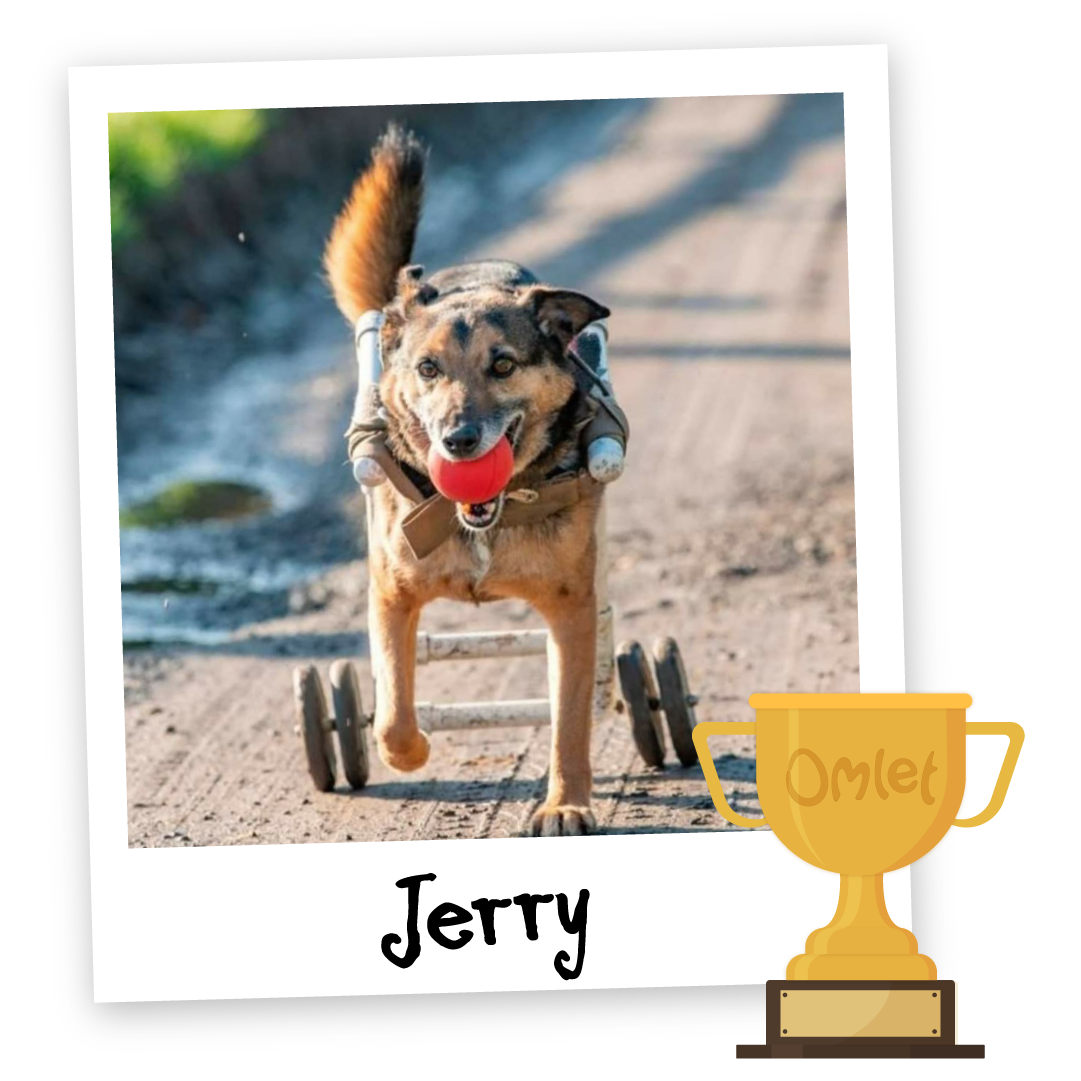
Jerry’s a cheeky, playful and boisterous rescue dog from Romania who can do a handstand! He landed on his feet when Shena gave him a home and inspired her to start a rescue centre specialising in disabled animals. Read the story here!
Pride of Omlet: The Constant Companion
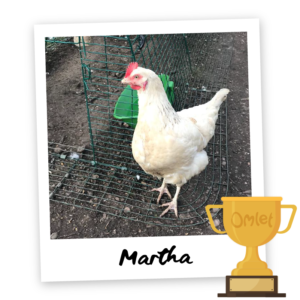
Martha’s humans Nicola and Ben bought chickens to bring joy to Julia, their mother who they cared for at home. The family could never have imagined that a chicken would become a caring companion to Julia in the advanced stages of dementia. Read the story here!
Pride of Omlet: Free Support
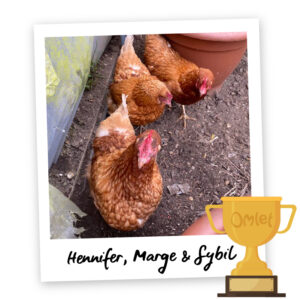
Once caged battery hens, Hennifer Marge and Sybil now work free-range with their human Jonathan, transforming lives for offenders at the Rosemead Project. Jonathan (support worker and chicken champion) believes the hens have the power to unscramble tricky social situations. Read the story here!
Pride of Omlet: A Perfect Match
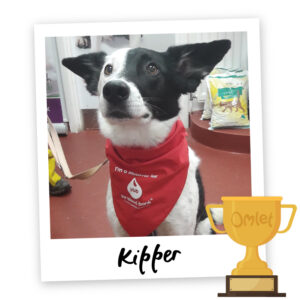
On paper, Kipper wasn’t exactly what Angela wanted. After years of behavioural challenges, he’s become the best-behaved blood donor and saved over forty dog’s lives. Kipper’s turned out to be Angela’s perfect match. Read the story here!
Pride of Omlet: Teachers Pet
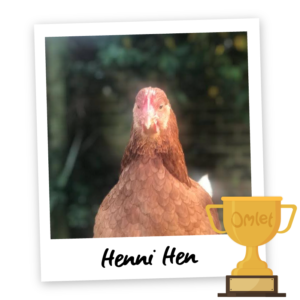
Henni Hen is a teaching assistant by trade. A cute and cuddly chicken who loves children. She follows in the footsteps of her bubbly humans, Hamish and Verity. Read the story here!
Pride of Omlet: Mipit Makes Sense

Mipit is a Mental Health Assistance Dog for his human, Henley. Mipit keeps Henly alive and independent. Who wouldn’t love a dog that can put out your recycling, answer your phone, and be your best friend, come rain or shine? Read the story here!
Pride of Omlet: Perfect Peaky
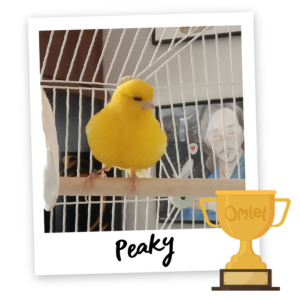
At the tender age of one, Peaky is already a retired filmstar. He had lived in a cage his whole life, released only to perform. When Joana and Fergus took him home, he was a fluffy, yellow bundle of nerves. But they are determined to help Peaky, their cute little canary companion, to come out of his shell. Read the story here!
Pride of Omlet: Saving Sophia’s Life
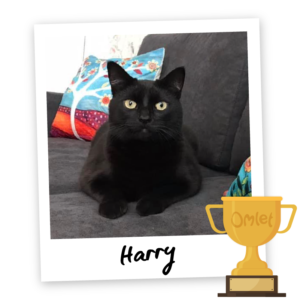
When you’ve grown up with animals, home isn’t home without a pet. Bringing Harry home was lifesaving for both him and his humans, Sarah and daughter Sophia. Harry has a special gift. He’s a unique epilepsy monitor, and he’s saved Sophia’s life countless times. Read the story here!
Pride of Omlet: Buster’s Beard

Buster was destined to chase balls on the beaches of Barry Island. He’s a lovable labradoodle with big brown eyes and a long beard. A thinker with a playful nature, he’s co-authored a children’s book with his human Natalie to bring Autism Awareness to all. Read the story here!
Pride of Omlet: Brave Bunnies

It’s hard to describe how frightened Pixie the rabbit was when the RSPCA rehomed her with an experienced rabbit owner. Eighteen months on, cheeky little Pixie lives in the lap of luxury and is learning to be loved by her adoring human, Wendy. Read the story here!
This entry was posted in Budgies
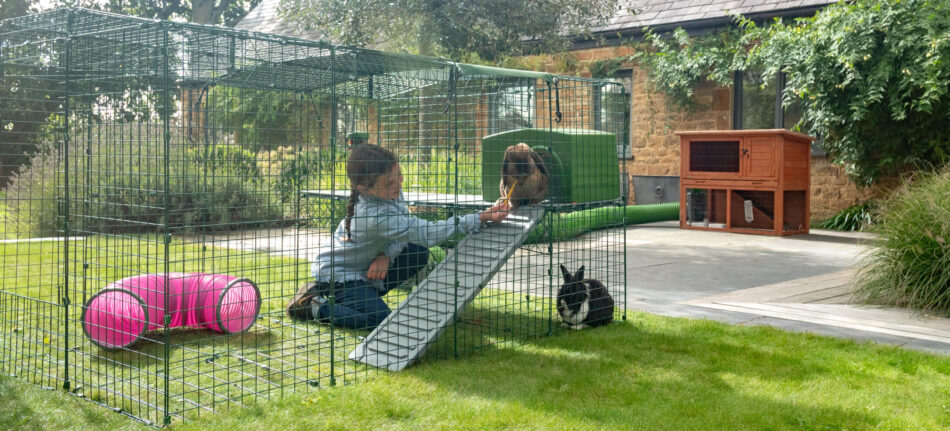
Rabbits that bond with their owners live longer, happier lives. Learning how to build a bond with your bunnies helps you enjoy their company even more, and forges a friendship that’ll span their entire lives. Since rabbits are prey animals, they have an innate nervous nature – and as a result, don’t give their trust as easily as dogs or cats may. But, with some patience, you and your rabbits will be able to understand each other better, deepening the bond between you. Whether you’re a first-time rabbit owner or a seasoned bunny keeper, here are 10 ways to bond with your rabbits.
1. Learn their personalities
Like humans, rabbits have their own distinct personalities and characteristics that set them apart from each other. Some rabbits are very shy when they’re first brought home, while others are outgoing and social from the start. Learning to read your rabbits’ body language is the first step in figuring out their unique personalities. Rabbits make different sounds and change their posture to reflect how they’re feeling. You may also find that you have two rabbits with completely different personalities toward humans – but having an outgoing rabbit can be helpful in gaining the trust of a more timid bunny.
2. Create a shared space
It’s natural for your rabbits to feel nervous or even defensive if you interact with them by reaching into their hutch – after all, this space is their home, and all of their instincts tell them to protect it from potential predators. If you want to spend time bonding with your rabbits, try setting up a play area or run large enough for you to sit inside with your pets. This way, you can start interacting with them on neutral ground. Rabbits feel comfortable when they have something over their heads, so don’t feel bad if the first few times they hide under any covered area you have set up.
While all bunnies should have a comfortable rabbit hutch, your first few interactions shouldn’t be inside of it. Rabbits seek shelter in the form of burrows or dens, which is how they see their hutch. Reaching into the hutch to pick up or pet your new rabbits can startle them, and can eventually create unease inside their safe space.
Instead of infiltrating their hutch, create a shared space in the form of a rabbit playpen. This will enable you to sit inside of an open area to let your rabbits come to you. Don’t be discouraged if your bunnies dart to the nearest cover during your first few attempts to pet them – this is their natural instinct shining through.
3. Offer healthy treats
While sitting in your shared space, offer your rabbits healthy treats by hand. There are plenty of fresh foods that you can feed your rabbits that will go a long way in winning their trust. Leafy greens in particular are both nutritious and easy to offer by hand – their length can be adjusted, gradually luring your rabbits toward you.
Once your rabbits are taking treats by hand, slowly encourage them to hop onto your extended legs or lap. While sitting on the ground, place the treats on your leg or hold them just over your lap. Before long, your bunnies will be bounding into your lap for food and attention.
4. Fill the playpen with toys
Placing more than just yourself inside of the shared space with your bunnies will help them adjust even faster to your presence. Bunnies love burrows, hideaways, and differing heights to gain a new vantage point. Adding Zippi Rabbit Tunnels, Zippi Rabbit Platforms, or Zippi Rabbit Shelters and Play Tunnels are all great accessories to help your bunnies feel more at ease and encourage play. It’s a good sign when your rabbits play while you’re in a shared space – it means they trust you enough to venture out of safety and exhibit their natural behaviours.
5. Give your rabbit new experiences
Rabbits are creatures of habit, but it’s good to change things up from time to time. New foods, toys, or run accessories are fresh and fun ways to break up monotony. And, over time, your rabbits will learn to associate you with these fun additions or changes to their routines. Try rearranging their run, re-routing or adding onto their Zippi Tunnel System, or offering homemade toys like empty paper towel rolls to brighten your bunnies’ day.
6. Petting your rabbit
Once your rabbits are comfortable sharing a space and taking treats from you, it’s time to introduce petting. Physical contact builds a stronger bond between you and your bunnies, but they may not take to it at first. The first time you stroke your rabbits, they may become startled and dart for cover. This too is a natural behavior– one that can be minimized over time. It can take several weeks to be able to pet your rabbits without this reaction.
The best way to introduce petting to your rabbits is to hold your hand low, just to the side of their heads. This way, they’ll be able to see exactly who and what is coming toward them. If you come straight from above their heads and backs, they can’t see what’s coming and will react just like their cousins in the wild running from a bird of prey or other predator. Also, avoid approaching your rabbit directly in front of their heads – they have a “blind spot” due to the location of their eyes, and are unable to see things coming toward their foreheads.
7. Teach your rabbits tricks
After your rabbits have adjusted to being petted, you can start incorporating some intellectual stimulation. Teaching your rabbits tricks will build their confidence, your bond with them, and foster their natural curiosity and behaviours. Start with simple tricks that come naturally to them, like walking through a tunnel or up a ramp with a treat waiting for them at the end. You can slowly build up to more advanced tricks like spinning in a cycle or rolling over. Rabbits can even be taught to play fetch like a dog.
8. Copying your rabbit
This method may seem unusual, but the goal is to behave in ways that your bunnies would expect from others of their own species. This could be you pretending to clean your “paws”, or leaning over to pretend to nibble at some of their food. Make sure you have your rabbits’ rapt attention, otherwise, you’ll be playing bunny charades by yourself. This method is particularly fun for children, especially those who aren’t old enough to have an abundance of patience to wait for their bunnies to come to them.
9. Choose the right time to play with your rabbit
As you observe your rabbits, you’ll see a pattern in their daily routine. There will be times of the day when they’re most active, when they prefer to nap, and when they seek out food or water. Learning their routine will help you determine the best time to play and socialize with them. Choose a time of day when they are most active – this will be the time when rabbits will be most receptive to play and training endeavours.
10. Learning to hold your rabbit safely
The last step in bonding with your rabbits is holding them. It may be tempting to push this step toward the top of the list, but it’s important not to rush them. Being held is the ultimate submission to humans – the truest expression of trust for a rabbit.
Always hold your rabbits in a way that’s most comfortable for them. This may be in a football hold, with your rabbit’s head tucked under your arm, or supported snugly against your body. Some rabbits even prefer being held on their backs – similar to how we hold human babies. Always be sure to support their hindquarters to help them feel secure.
Omlet and your rabbits
Rabbits are gentle animals, and need gentleness in return. Being respectful of your rabbits’ space, personalities, and insecurities will help them see you as a friend instead of a foe. Starting them out in an Eglu Go Rabbit Hutch will begin building the bond between you and your bunnies with confidence and security. And, when you add a Zippi Rabbit Playpen, you’ll be able to cultivate a lasting relationship in a shared space that you can customize and tailor to your rabbits’ needs throughout your lasting relationship.

This entry was posted in Pets

This article is a part of our Pride of Omlet series, a collection of amazing stories which shine the spotlight on extraordinary pets and share their selflessness, bravery, talent and compassion with the world.
-Written by Anneliese Paul

It’s hard to describe how frightened Pixie the rabbit was when the RSPCA rehomed her with an experienced rabbit owner. Eighteen months on, cheeky little Pixie lives in the lap of luxury and is learning to be loved by her adoring human, Wendy.
Wendy had two beautiful rabbits, which she adored. A jet black male Rex rabbit called Jensen and his chocolate brown partner, Havana. But in 2019, Havana died suddenly of pneumonia, and Jensen grieved so severely that he wouldn’t leave his bed. He was the most miserable, unhappy rabbit.
Wendy wanted him to bond with another rabbit, so she went to the RSPCA Canterbury and found Pixie, who had been severely neglected. Pixie was rescued with her partner, but sadly, this rabbit didn’t survive. Pixie was close to starvation, she was skin and bones and had to be fattened up before she was ready to be rehomed. Wendy wanted to give her the loving home she deserved.
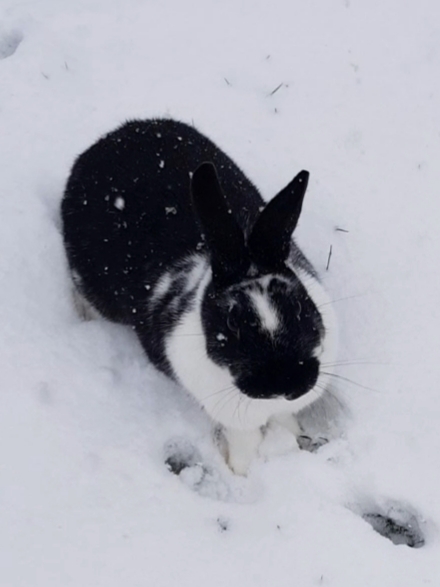 Thinking she would be a perfect match for Jensen, Wendy took Pixie home. She had divided the rabbit house so that she could slowly introduce them. After about a month, they were lying next to each other, separated only by the wire, so Wendy decided it was time. But Pixie was traumatised and her fear presented in aggressive behaviour. She couldn’t handle it and bit Jensen. She was agitated and frightened of everything. For a while, even putting food down for her was tricky. She would lunge at the hands that fed her. It was a terribly sad time for Wendy to see Pixie so distressed.
Thinking she would be a perfect match for Jensen, Wendy took Pixie home. She had divided the rabbit house so that she could slowly introduce them. After about a month, they were lying next to each other, separated only by the wire, so Wendy decided it was time. But Pixie was traumatised and her fear presented in aggressive behaviour. She couldn’t handle it and bit Jensen. She was agitated and frightened of everything. For a while, even putting food down for her was tricky. She would lunge at the hands that fed her. It was a terribly sad time for Wendy to see Pixie so distressed.
Wendy kept Pixie on her own, and slowly slowly, Pixie began to trust her. Now, 18 months on, she puts her nose up to be stroked, and she’ll hop alongside Jensen. Their Omlet runs, run parallel, so she’s got her space, and he’s got his. They also have a shed divided in two with three levels, windows, balconies, and a flap to their outside Omlet runs, which are connected with tunnels to the conservatory. The gate system on the Omlet runs means Wendy can let them both have time in the house. What was once Wendy’s dining room is now a rabbit playroom with a box, some steps and tunnels so they can just mess around and do bunny stuff. They take turns to come in, and Wendy leaves the door open, so they don’t get too warm.
Before she starts work in the morning, she makes the rabbits a little salad. Kale, Cavalo Nero or Spring Greens are the staples, mixed with herbs like parsley, mint and basil. And in the summer, she’ll pick fresh leaves and rose petals. They have 3 or 4 different kinds of hay to choose from in their runs, and for a treat, Wendy likes to give them bunny biscuits, or strawberries which they absolutely love.
From her sad beginnings, Pixie has blossomed with a loving owner who understands her past, builds up her confidence and feeds her a delicious diet. And Jensen has a new partner, Tinkerbell, a blue-eyed white mini Rex. Wendy simply adores all three of her beautiful rabbits, but especially Pixie. She’s a survivor.
“Almost every day, she could reduce me to tears. She’s so loving and responsive. I’m just absolutely amazed that this little rabbit found it in her heart to actually forgive humans.”
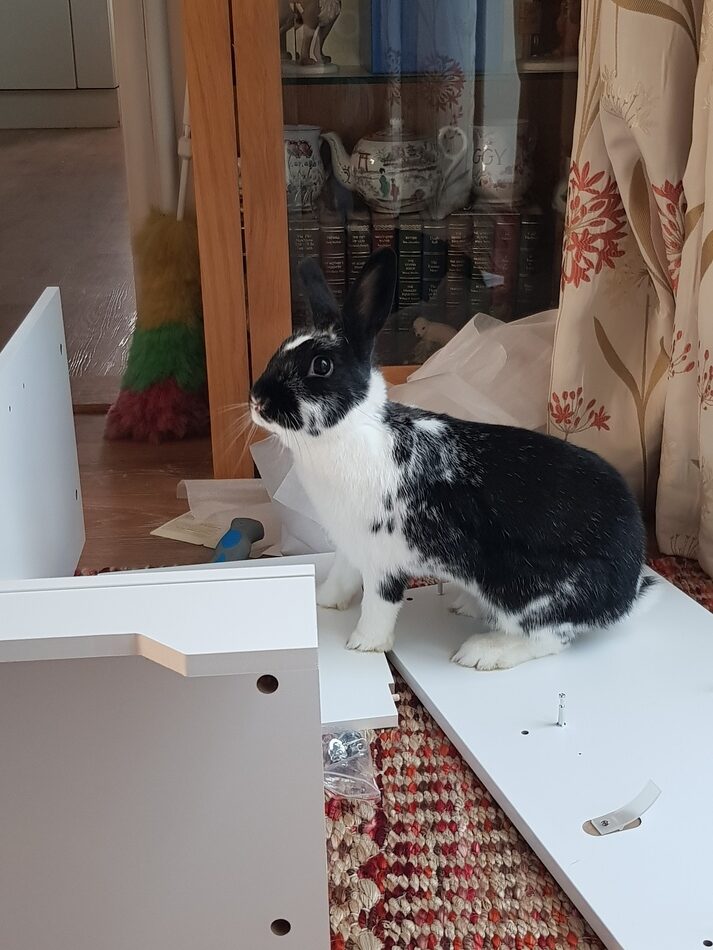

This entry was posted in Pride of Omlet

Some pets, including rabbits and guinea pigs, are naturally vegan. Hamsters and gerbils, although omnivorous, can thrive on a vegan diet in which the protein content is supplied by plants and vegetables. Others, including omnivorous dogs and out-and-out carnivore cats, cannot be easily pleased on meat-free diets.
All animals need to have their nutritional needs satisfied. But this does not mean you can’t have a vegan dog. Vegan cats, though, are a lot trickier.
Can my dog have a vegan diet?
 If you were to meet a species of animal for the first time and had to make an accurate guess about its diet, you would get lots of clues by looking at its teeth. The teeth of a dog, like the teeth of a bear, proclaim loud and clear that this animal is an omnivore – that is, one that eats both meat and vegetables. If you think of your dog as a domesticated wolf, you get a good idea of its natural diet.
If you were to meet a species of animal for the first time and had to make an accurate guess about its diet, you would get lots of clues by looking at its teeth. The teeth of a dog, like the teeth of a bear, proclaim loud and clear that this animal is an omnivore – that is, one that eats both meat and vegetables. If you think of your dog as a domesticated wolf, you get a good idea of its natural diet.
However, as the panda proves, a supposed meat-eater can sometimes get by perfectly well on a vegan diet. A panda’s teeth are similar to any other bear’s – long canines for meat-eating and molars for grinding vegetation. And yet pandas don’t eat anything other than bamboo. So, if a bear can be vegan, does that mean you can have a vegan dog?
The answer is yes – but it’s a yes with lots of small print! A dog requires a diet that contains the fats and proteins it would get from meat. It is dangerous to ignore this basic need and simply feed your pet with whatever you please. Some dogs have delicate stomachs at the best of times, and a low-fat, high-fibre diet can cause potentially life-threatening problems. A diet that excludes meat should never be fed to a dog without the advice of a professional pet dietician.
The collagen, elastin and keratin found in meat diets are not easily replaced by vegi equivalents. Your dog will also need the ‘long chain’ omega-3 fats found in animal products such as egg, fish and some meats. Vegan omega-3 fats are not the same as animal-derived ones.
All of which presents a headache for the vegan dog owner. There are, however, products available that claim to let your dog live a healthy, meat-free life. Before you take the plunge, it is essential to seek professional, scientific advice and guidance. Compromise is usually the best choice here – a vegan diet supplemented by some of the animal-derived essentials. Crickets, for example, can provide lots of the amino acids and keratin a vegan diet lacks, and they’re 65% protein.
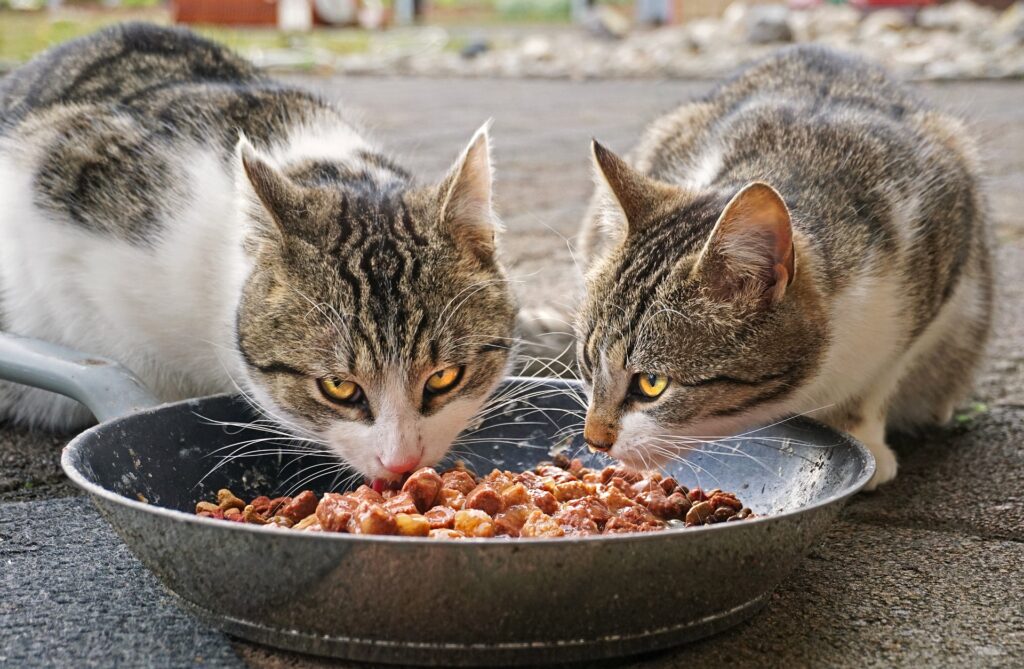
Can my cat have a vegan diet?
The compromise approach is even more important for cats. These are amongst the planet’s true carnivores, obtaining all their dietary requirements from other animals.
The main challenge with minimising the meat in a cat’s diet is that, unlike many mammals (including dogs), cats cannot produce certain proteins. They have to absorb these from the meat and fish in their diet. Amino acids are another issue – cats deficient in the animal-derived amino acid taurine, for example, usually succumb to a specific type of heart problem.
Even a fortified vegan cat food cannot be confidently recommended. Turn the situation on its head, and try to imagine weaning a rabbit onto a meat-only diet, and you get some idea of the challenge – and the ethics – involved.
There are some lab-grown ‘meat’ products in development, with vegan and vegetarian cat owners in mind. However, whether these will arrive – and remain – on the market any time soon is hard to guess.
For many vegan pet owners, there is a huge ethical issue involved in feeding the animals they share a space with. Ethics, however, include the animal’s needs too, and it’s an almost impossible issue to resolve when it comes to cats. If you are able to reduce but not eliminate the meat in your cat’s diet, that’s the safer option.
Top 10 pets for vegan households
There are, of course, plenty of other pets that don’t eat meat, or that eat some meat but can still thrive on a meat-free diet. Here are our ten favourites.
 1. Rabbits. No problems here – rabbits are happy vegans, with diets based on hay and vegetables. You could argue that the soft pellets they eject and then eat are animal products of a sort, but they are simply semi-digested vegetation.
1. Rabbits. No problems here – rabbits are happy vegans, with diets based on hay and vegetables. You could argue that the soft pellets they eject and then eat are animal products of a sort, but they are simply semi-digested vegetation.
2. Guinea pigs. Like rabbits, these wonderful little characters thrive on a 100% vegan diet.
3. Hamsters. As most hamster owners feed their pets with shop-bought hamster food, they may not be able to say exactly what the ingredients of that food are. However, vegetarian and vegan hamster foods are readily available.
4. Gerbils. Like hamsters, gerbils are omnivores that can live happily on a vegan diet. They tend to have rather delicate stomachs, so feeding them with a high-quality pellet mix is essential. Too much fresh stuff can cause problems.
5. Mice. Although they will eat pretty much anything in the wild, mice can thrive on vegan diets; but it is still best to use a food mix prepared specifically for them. This ensures that they will not be deficient in any of the vitamins and minerals they need.

6. Rats. These are the most omnivorous of rodents, but as long as you feed them a vegan mix that has been fortified with all the nutrients they need, they will thrive. Indeed, rats who eat too much animal fat tend to become fat and die prematurely.
7. Chickens. If you watch a free-range hen, it soon becomes clear that she will eat anything – grass, beetles, worms, and everything in your veg patch if you’re not careful! Most chicken feed emulates this mix of plant and animal products. However, it is possible to buy vegan chicken feed, and circumstantial evidence suggests that hens can thrive on it. However, they are likely to produce fewer eggs, and you will not be able to stop them scratching for worms and bugs, no matter how vegan the layers pellets are!
8. Budgies and parrots. Vegans will have no obstacles to face with budgies and parrots, unless the birds are being bred. Egg-brooding female birds need a protein boost, normally delivered via an egg-based food or cooked meat. Vegan alternatives are available, though.
9. Finches. Many finch species enjoy bugs and mealworms as treats, but these are not an essential part of an adult finch’s diet. These birds thrive on a mixture of seeds and fresh vegetables.
10. One for reptile fans. When you think of pet snakes and lizards, you probably have an image of dead mice or doomed crickets. However, there are a few commonly kept pet reptiles that eat a 100% vegan diet, the most popular being the Green iguana. Getting the balance of vegetables just right is very important for the animal’s health, but meat is certainly something you won’t have to worry about.
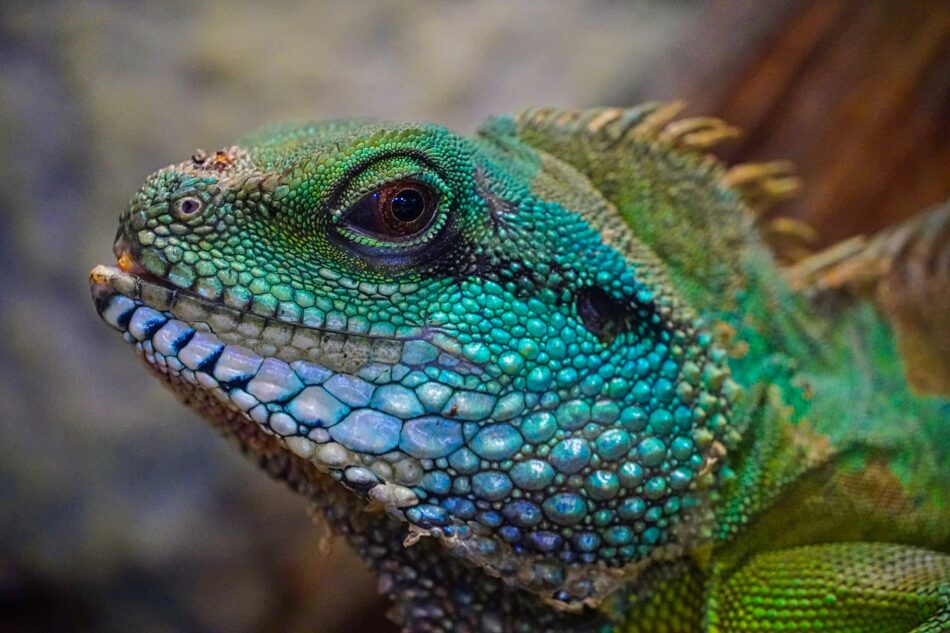
There is no shortage of choice when it comes to vegan pets. Keeping a vegan cat or dog is a much trickier proposition, though. And with all these animals, a balanced diet that matches the pet’s nutritional requirements should be your primary goal.
This entry was posted in Budgies

Rabbits are usually peaceful creatures who love to play and socialise with their owners. But what do you do if your rabbit starts showing signs of aggression? It’s tough to see your pet stressed, and it’s natural to want to help them. Here, we outline a few ways you can minimise bad bunny behaviour and start enjoying the time you spend with them again!
What is aggressive behaviour in rabbits?
There are two major kinds of aggression in rabbits, the most typical being defensive behaviour surrounding their habitat. If your rabbit bites when you reach your hand into their cage or hutch, it’s likely to be territorial defensive aggression. Another kind of aggressive behaviour occurs between your rabbits – for example if they are fighting each other to the point of injury.
It can be upsetting to see your bunny get hurt, and hard to know what to do. A small amount of fighting is natural between your pets, but if you can see blood on their fur or in the hutch then it’s possible that the anger is getting out of hand and the bites are getting nasty.
How to help with territorial aggression and biting
If your rabbits bite your hand – or try to – consider how and where you approach your pet. The hutch is often a bolt hole and ‘safe space’ for a bunny and is where they spend most of their lives. If you reach in unexpectedly, it is natural that they might be scared and defensive. Rabbits are prey animals in the wild and are especially jumpy when ‘cornered’ in their safe space!
You may find that if you start to interact with your rabbit in a non-hutch setting – such as a run or play area – you have more chance of a peaceful and happy interaction. Try sitting with your rabbit in the run for a few hours every day, and then begin to slowly approach with your fluffy friend’s favourite rabbit treats. After spending time like this, you may find that your rabbit starts coming to you more and more, and if the rabbit is initiating the approach, aggression is much less likely.
By spending time with your rabbit in this non-hutch environment, you are teaching your pet that you are not a predator, and that you can be trusted to approach them. Once the trust is established, you should be able to approach the rabbit in its rabbit hutch with no problems.
How to stop aggressive behaviour between your rabbits
If you have noticed fighting between your rabbits, and if this seems to be more than just their normal play fighting, you may need to think about how much space they have in their hutch. It could be that your rabbits have grown since you bought them, and their once spacious house is now a little too small for two. It could be that they have spent little time in the run over winter, and so they’ve become a little ‘house-bound’ in their hutch. Cabin fever affects humans and pets alike!
Whatever the reason for the bunnies’ bad moods, it is important that your rabbits should feel happy and relaxed in their hutch. The fighting will likely ease off if they have more elbow room. Rabbits are territorial animals, and they each need their own space as well as a shared space.
Try distracting your brawling bunnies by clapping your hands. The noise will distract them and will hopefully teach your rabbit not to fight. A particularly aggressive rabbit can be deterred by spraying water on their nose – but this isn’t something you want to be doing too often, so if, after the first few sprays, it isn’t making any difference, it’s time for Plan B.
If you decide to invest in a larger hutch but your rabbits continue to show aggressive behaviour, you may have to separate them into two different hutches. That’s Plan B!
The benefits of spaying rabbits
Spaying (also known as neutering) is the term for stopping your pet from having babies and is accomplished via surgery. If your rabbits were from a pet shop, it is likely that they have already been spayed – but if you got your rabbits from a friend, it’s always a good idea to take them to the vet and ask about spaying.
If your rabbit has not been spayed, they are much more likely to exhibit aggressive behaviour to you and any fellow bunny who shares their hutch.
It is common for owners to keep male rabbits or female rabbits in single-gender pairs, and this can lock them into a mating-related feud that neither can win. Your rabbits could be fighting over who is the most dominant in their shared territory, but this fighting is much less likely to occur if they have been spayed.
Equally, if you have decided to keep a male and female rabbit together, it is a good idea to get them spayed, as rabbits can have up to fifty baby bunnies a year! Fifty bunnies may sound cute but consider how difficult it could be to care for and house that many animals!
There are other benefits to spaying your rabbit other than reducing their aggression, such as reducing their chances of getting mammalian, ovarian or testicular cancer. Spayed rabbits are also much easier to train, and are more sociable generally.
If you have only recently brought your pet rabbit home, they may need a little time to get used to their new space and become comfortable. It is natural for any new pet to be nervous and skittish at first, and this could lead to a few aggressive behaviours, including biting, early on.
It’s important to know that your rabbit is more scared of you than you are of it, and that just because it has bitten you doesn’t mean that you won’t end up being the best of friends! If you feel nervous about establishing contact with the rabbit, talk to a friend who has had rabbits for a little longer, or check out some of the reassuring ‘how to’ guides available online.
Just remember that having a rabbit is hugely rewarding and it’s worth spending time hand-training your pet from the outset. As long as they have enough space and no aggressive ‘mating rivals’, they should be every bit as calm and cuddly as you could hope for.

This entry was posted in Rabbits
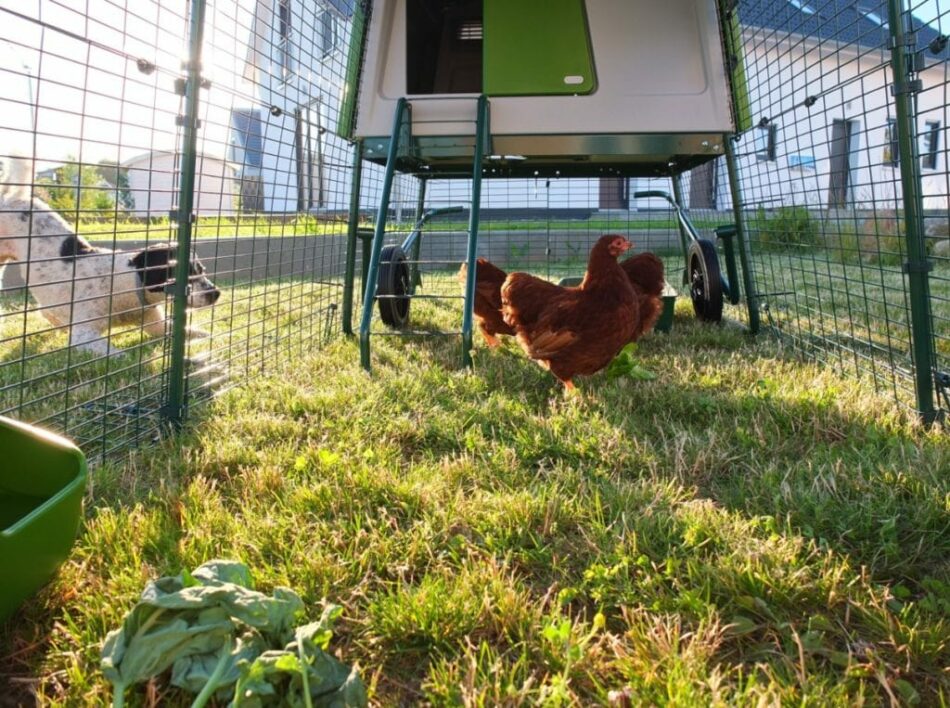
You can keep chickens with other pets when the proper preparations and precautions are in place. Some pets like cats and dogs may have an innate prey drive that chickens can trigger, so it’s important to take introductions slowly to ensure success. With these tips, you’ll be able to confidently introduce your current pets to your chickens, or introduce new pets to your existing flock with confidence.
Keeping chickens with dogs
Dogs are the most common pets in the world, with millions kept as pets across the country. So, if you’re among the many dog owners, adding chickens to your family is possible once you consider your dog’s temperament and trainability.
Assessing your dog
If you’re a dog owner, the first thing to consider is their temperament. Different dog breeds may also react differently to birds as part of their nature. For example, breeds like Labrador Retrievers or German Shorthair Pointers may become easily excited around birds due to their natural hunting and retrieving drives. Other breeds that may have increased prey drives include:
Regardless of their breed, if your dog becomes excited or overly curious around small animals, their behaviour will likely carry over to chickens. If your dog loses their mind over the birds at your backyard feeder, or drags you to investigate the park ducks on your evening walks, they’ll likely stress out your flock – and themselves.
Dogs without a prey drive or with little interest in birds will likely not pose a problem to your chickens, but all dogs react differently when new pets enter their territory. Usually, most dogs will adjust to the new backyard occupants just fine after an acclimation period. You will likely see your dog expressing interest in your chickens at first – hanging around and sniffing the coop. They may even express a desire to interact with your chickens through playful postures and behaviours. Understanding your dog’s body language around your chickens will help you determine what their relationship will be like.
Chickens are prey animals, and can be hurt easily. Dogs cannot play with chickens as they would with other dogs or even other pets. It’s important to teach your pup that chickens are fragile friends – not toys or something to hunt.
Teaching dogs to get along with chickens
Unless leashed walks make your dog overly excited, their first encounter with your chickens should be done with a dog collar and lead. Make sure their collar is tight enough that they don’t slip out, but not so tight that it’s uncomfortable. Walk your dog up to your chickens’ enclosure and let them sniff. Maintain a tight leash until you see your dog’s reaction, and allow the lead more slack slowly to reinforce good behaviour.
Let your dog watch you spend time with your chickens. This should be done with your chickens in the safety of a strong walk in chicken run. If your dog does more than sniff or hang around the run, take a step back and approach their interaction from a different angle.
It could take several weeks for your dog to fully accept your chickens. Some other ways to help your dogs adjust to your chickens include:
- Setting up chicken fencing around the outside of your flock’s run for your dog to observe them at a distance.
- If your dog has a run or playpen, place it next to your chickens’ run and slowly decrease the distance over several days until they are side-by-side.
- Reward your dog with their favourite treats each time they are calm around your chickens.
Make sure to never leave your dog unattended with your chickens – especially in the beginning. Even if they can’t get into the run with them, an excited dog’s barking can easily stress your flock out.
Keeping chickens with cats
Cats are more difficult to train than their canine counterparts, and are decidedly less predictable in their behaviour. But the good news is that most cats don’t see a large hen as potential prey the same way a dog might. Most cat owners will agree that their cats show little to no interest in their chickens. In fact, cats and chickens have a somewhat symbiotic relationship.
Birds and their feed attract rodents, which a cat would much prefer over your hens. So, when your cat is able to patrol your chickens’ surroundings, chances are good that any potential rodent problem will be nipped in the bud.
Some cats may show increased interest in your hens. This largely depends on your cat’s breed and temperament. Cats will pose a greater threat to chicks rather than grown hens, but by keeping your flock in a strong chicken coop and run, you’ll ensure they stay safe from your cat.
Keeping chickens with guinea pigs
It may be tempting to keep some cute cavies in with your chickens, but in reality it’s not wise. Chickens will likely pick on them, and with their short legs, guinea pigs can’t get away from them quickly. Their dietary requirements are also very different, and your chickens may eat your guinea pigs’ food in favor of their own, which means neither animal will be getting the nutrients they need. If you have cavies and want to house them near your chickens, it’s best for them to have their own guinea pig hutch and run.
Keeping chickens with rabbits
Rabbits on the other hand are fast enough to fend for themselves against chickens, and if raised together from a young age, can do well around chickens. Still, they require their own dietary needs and clean sleeping quarters. They don’t roost like chickens, so they’ll need their own burrowing space in the run or under the coop.
The easiest way to achieve this is by adding walk in chicken run partitions. This will allow you to create “rooms” for each species to ensure they all get what they need. You can open the partition doors to allow everyone to be together whenever you’d like, or create a third space as a common area.
Remember to try to give each species as much space as possible in their respective areas to make them feel safe and comfortable.
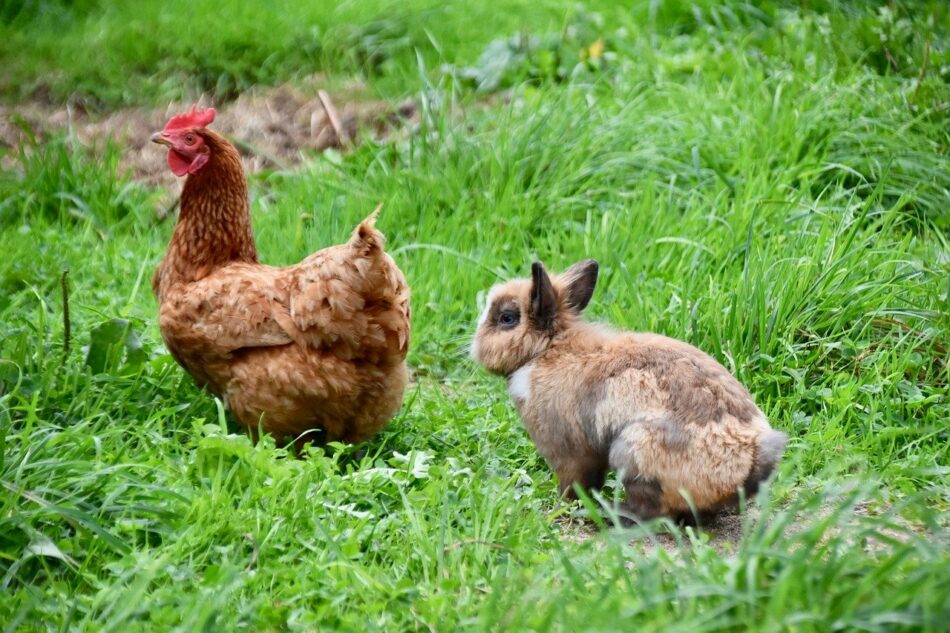
Chickens and other pets
Chickens can also mix happily with goats, and with female ducks (males will tends to bully them). Ironically, they do not mix with birds in an aviary. They will eat anything that falls to the aviary floor, but they will also happily peck the other birds whenever they can and may attract rats and mice, which will cause problems for the smaller birds.
If you live in a rural setting, you can keep chickens with other barnyard animals. Chickens mix happily with:
- Goats
- Sheep
- Cows
- Alpacas or llamas
- Pigs
- Female ducks, guinea fowl, peacocks, geese, or pheasants
Any other avian species kept with chickens should be docile and preferably female, as males can bully hens. Smaller birds like quail or pigeons will likely get pecked at by chickens, so it’s best to stick with larger birds as run-mates. Small pets like hamsters, gerbils, turtles, or frogs should never be kept with chickens – they will be pecked at and killed.
Omlet and your pets
Omlet has all of the pet products you need to keep your furry and feathered family members healthy and happy. Having multiple types of pets is exciting, and through our line of chicken coops, chicken runs, and walk in run partitions, you’ll be able to create a safe haven for all of your animals to enjoy. And, by knowing that Omlet products are protecting your flock, you can rest easy knowing that you’ve provided them with the best chicken housing solutions available.
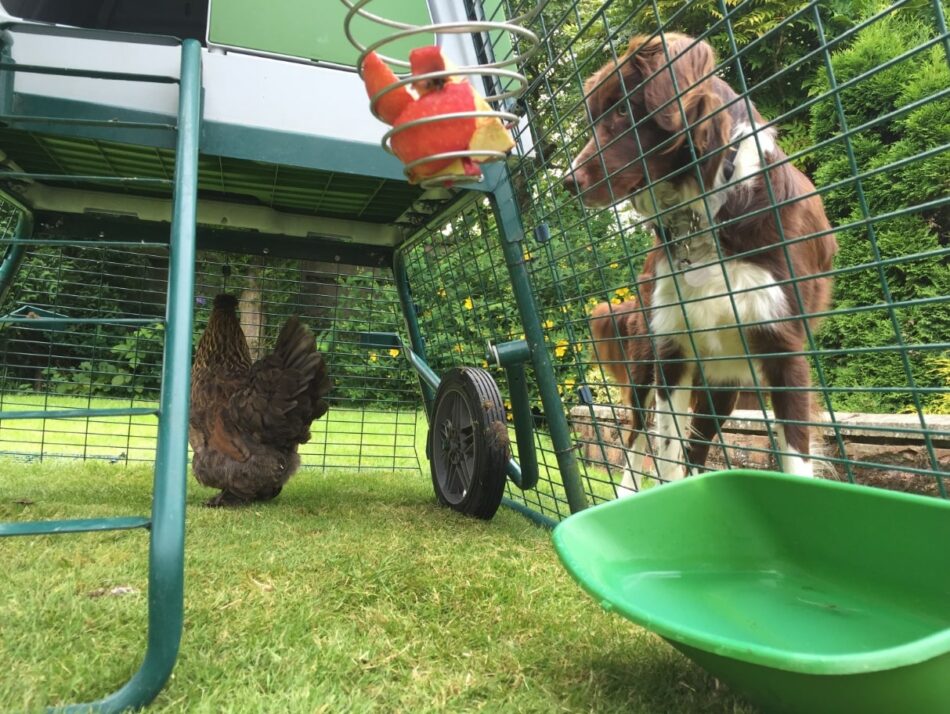

This entry was posted in Budgies
Wondering how to teach your guinea pigs and rabbits new tricks? One of the most rewarding experiences you can have with your pets is through teaching them tricks— and it’s a lot easier than you might think. Rabbits and guinea pigs are social animals that benefit from spending time with their owners through learning and playing. Discover how teaching your pets new tricks is a fun way to build their trust and confidence.
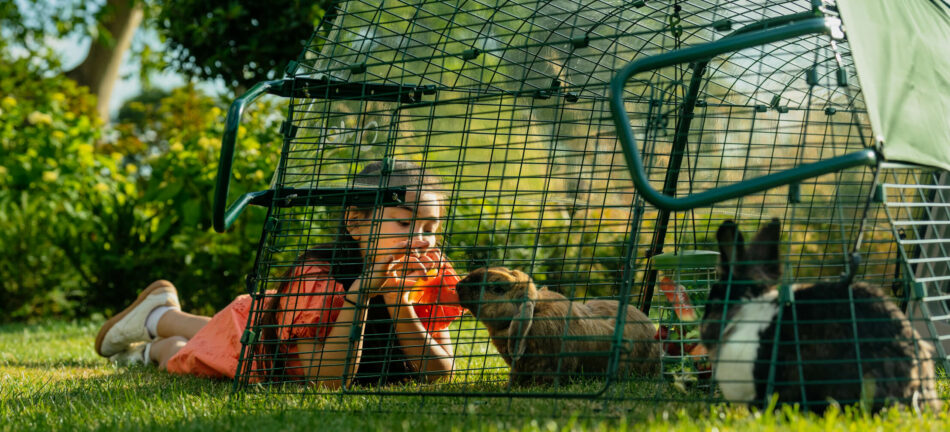
How to start training your guinea pigs and rabbits
Training rabbits or guinea pigs is most effective when you can repeat it every day – even if it’s only for five or ten minutes. Not only will your pets appreciate the extra attention, but having a repeated routine will help them remember the tricks you’ve taught them.
To teach your guinea pigs and rabbits tricks, the first thing you’ll need is a quiet space free from distractions. Zippi Rabbit Runs and Playpens are ideal, giving you a secure and familiar space where you and your pets can focus. You will also need some of your rabbits’ and guinea pigs’ favourite treats to encourage them and reinforce their learning.
It can be helpful to separate your pets when training them, but some pets can benefit from learning from each other. For example, if you have an older trained rabbit and a young, untrained one, the young rabbit can learn tricks easier by copying their more experienced friend. And don’t worry about old dogs and new tricks – your pets are never too old to pick up new things.
Rabbit and guinea pig tricks for beginners
When you start to train your guinea pig or rabbit, it’s all about patience and perseverance. Your pet might not seem interested in learning initially, but as you continue to reinforce their learning with treats, you will find them routinely coming back for more. Start with something simple, such as “circling” — a perfect trick for both rabbits and guinea pigs.
Training your rabbit or guinea pig to circle
To teach your pet how to perform a circle, grip a treat tightly between your fingers and hold it close to your pet’s mouth. Then lead your pet around in a circle with the treat, so that it spins in a tight circle. Repeat this until your pet spins around without you leading them, occasionally reinforcing them with the treat. It’s important that you only give them a reinforcement treat when they successfully do the trick. Eventually, the flick of your wrist will be all the encouragement that your pet needs to perform this trick — provided that there’s a treat in store for them after their performance.
Don’t worry if this takes some time to learn – the first trick can be the hardest for your rabbit or guinea pig, but once they have mastered a circle, you’ll both have the confidence to learn even more tricks. If your pet is struggling learning how to circle on command, try encouraging them to turn in the other direction. Like us, our pets are either left or right-footed, so the direction you ask of them needs to be in line with their natural inclination.
How to make rabbits or guinea pigs come when called
Another great first trick is teaching your rabbits or guinea pigs to come when they’re called. Not only is it endearing and impressive, but it’s also practical for your pet to approach you on command.
As with many tricks, the key to teaching your rabbit or guinea pig to come when called is food. Offer a treat when you are close to your pet while saying their name. Eventually, they will come to associate their name with the treat. The next step is to call your pet from farther away, showing them the treat. Repeat their name as they take their reward. After two weeks of this regular exercise of calling and treating, try calling your rabbit or guinea pig’s name without showing them a treat.
Moving on to more advanced tricks
Once you and your guinea pigs or rabbits have mastered a first trick, it’s time to move on to more advanced feats. The more tricks your pet learns, the more confident they will become — and the closer your bond will be.
How to teach rabbits and guinea pigs a ‘figure of eight’
Challenge yourself and your pets by encouraging them to walk in a figure eight between your legs. As with teaching them to circle, hold a treat in front of your rabbit or guinea pig while encouraging them to follow a figure of eight pattern through your legs. Reward them with the treat as soon as the pattern is complete. Some pets may need a treat halfway through their pattern to maintain their focus — but eventually they’ll learn to complete the figure eight before expecting their reward.
How to make rabbits and guinea pigs jump through hoops
To teach your rabbit or guinea pig to jump through a hoop, you’ll need a stick and some treats. Begin this method of stick-training, hold the tip of the stick near your rabbit or guinea pig. When they turn to investigate it, offer them a treat. This will reinforce the idea that the stick is associated with treats.
Once they’re familiar with this routine, hold a hoop close to your rabbit or guinea pig, slightly off the ground. Hold the stick on the opposite side of the hoop, and wait for your pet to hop through to the stick. Offer a treat as soon as they’ve completed the hop. Once your rabbit or guinea pig is hopping through the hoop toward the stick, you can offer the hoop without the stick. Reward them with a treat as soon as they hop through.
You can slowly increase the height of the hoop for rabbits, but keep in mind that guinea pigs will only be able to perform a slight hop. Rabbits can reach impressive heights thanks to their acrobatic prowess, so be sure to offer a challenge to them.
Remember: treats are in moderation
Don’t forget that the treats given to your pets are a part of their diet — and if you’re sticking to your daily training, you may need to incorporate healthier snacks as training-treats to make sure their diet remains balanced. Leafy greens, green beans, carrot tops, or herbs are all great treats that are both healthy and satisfying for your guinea pigs and rabbits.
Omlet and your guinea pigs and rabbits
Help your rabbits and guinea pigs reach their full potential and amaze yourself in the process. With Zippi Tunnels and Zippi Run Platforms, you’ll be able to teach your pets new tricks with ease, and give them the elements they crave in their environment between training sessions. And, with our outdoor rabbit and guinea pig runs, you’ll have the space you need to achieve all of your trick-teaching goals.


This entry was posted in Guinea Pigs
Older rabbits need a little extra care. But when exactly is a bunny ‘old’? It very much depends on the breed. Larger rabbits have shorter lifespans than smaller ones, which means they become senior rabbits sooner than medium and small breeds.
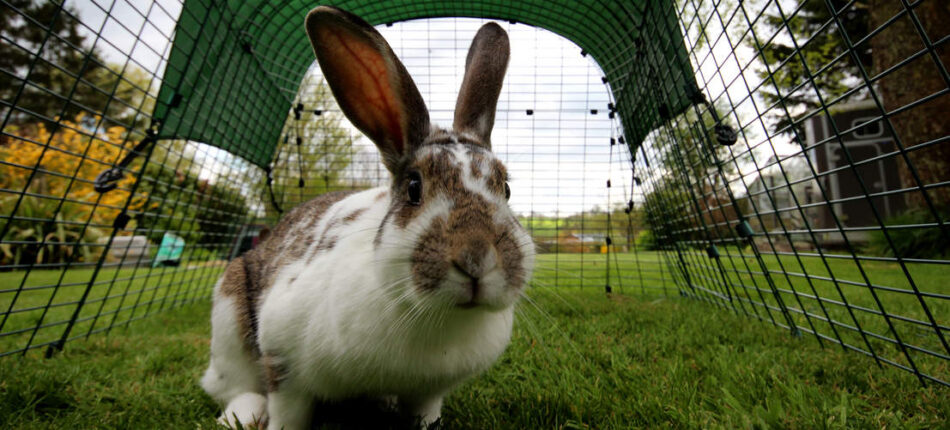
At what age is a rabbit considered old?
As a general rule of thumb, small rabbit breeds, which live around 12 years, are seniors when they reach 8. Medium-sized rabbit breeds live up to 10 years and can be considered senior at 6 years. The large rabbit breeds have much shorter lifespans – just 4 to 7 years – and reach old age at 4.
The shortest-lived rabbit breeds are like small pets such as gerbils, hamsters and rats, in that they only have a few months of senior status at the end of their lives.
How do you take care of an old rabbit?
Here’s how to make sure those senior rabbit years are as healthy and happy as possible.
Make sure you give them the right food
Rabbit care is largely about food, and a healthy diet is essential throughout a rabbit’s life. As your bunny gets older, you should consider buying specially formulated pellets or nuggets. There are several different brands, and they contain the optimal balance of vitamins and minerals for ageing rabbits. Older rabbits mustn’t gain too much weight – or, indeed, lose weight – during this dietary transition, so you should weigh them regularly to maintain the correct weight. In addition to the special pellets, senior rabbits should be fed lots of hay and fresh foods as usual.
Don’t add supplements to your rabbit’s diet
Rabbits get everything they need from a diet of hay, fresh food and appropriate pellets. Extra calcium, for example, can cause digestive problems or stones in the urinary tract.
Make sure your bunny gets plenty of exercise
Getting old doesn’t mean sitting around all day – rabbits of all ages need to move around to stay happy and healthy. A run will naturally allow your bunnies to hop, skip and jump, and a tunnel layout such as Omlet’s Zippi system is nothing short of essential. These run layouts keep your rabbit exercised both mentally and physically, which is all part of healthy old age. You can use rubber-backed mats on steep or slippery surfaces, to enable the rabbit to get a better grip.
Provide quiet spaces
Senior rabbits are less active than young bunnies and appreciate a quiet space away from the action. A cosy corner in the hutch will keep a tired rabbit happy, with lots of soft bedding, is essential. Incorporating ‘safe spaces’ in your run helps too. If you use a Zippi Rabbit Platform, the space created has the dual purpose of providing a quiet corner high up in the run, and also gives your pet rabbit exercise as it climbs up and down.
Keep the hutch lined with soft bedding
Senior rabbits can develop pressure points and sores or a foot condition called pododermatitis. This is caused by hard surfaces or wire meshing on the floor of a run. Good senior rabbit care means looking after sore feet!
Keep bunny claws clipped
Senior rabbits tend to move around less, and as a result their claws can soon become overlong. Regular clipping is required. If you’re not comfortable performing this, ask your vet for help.
Provide shelter from the elements
In addition to that cosy corner in the rabbit’s hutch, some weatherproofing to shield your ageing bunny from the elements will increase the comfort factor, whatever the weather. A Zippi Rabbit Run Weather Protection cover is the perfect way of keeping the worst of the weather at bay.
Carry out regular health checks
Older rabbits are prone to dental diseases and other health problems. If your bunny loses its appetite, loses weight, salivates, produces fewer droppings or has swellings around the mouth, it could be a sign of dental problems. Ask your vet to perform a thorough dental examination. Arthritis can be an issue, too, and a bunny who has slowed down may benefit from anti-inflammatory drugs. Older rabbits may also soil their back legs, and this can cause skin problems or fly infestation. Again, the vet will be able to prescribe treatments to address all aspects of your rabbit’s health.
Reduce obstacles
A rim around a litter tray, or a tunnel that rabbits have to hop over to get to the other side of the run, can cause problems in older rabbits who can no longer hop over things. Rearranging the run furniture and providing easy access to litter trays indoors is the answer.
Take your bunny for regular check-ups
The best way of keeping on top of problems is prevention. A vet will be able to spot problems before they become debilitating and will usually be able to offer remedies and advice.
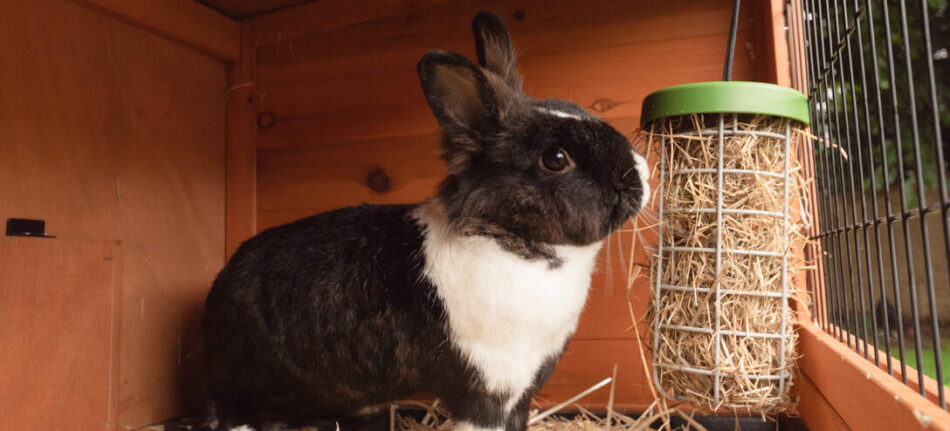
Getting old is part of life. A healthy rabbit will take it in their stride, though, as long as you pay attention to the little details that make all the difference.
This entry was posted in Rabbits
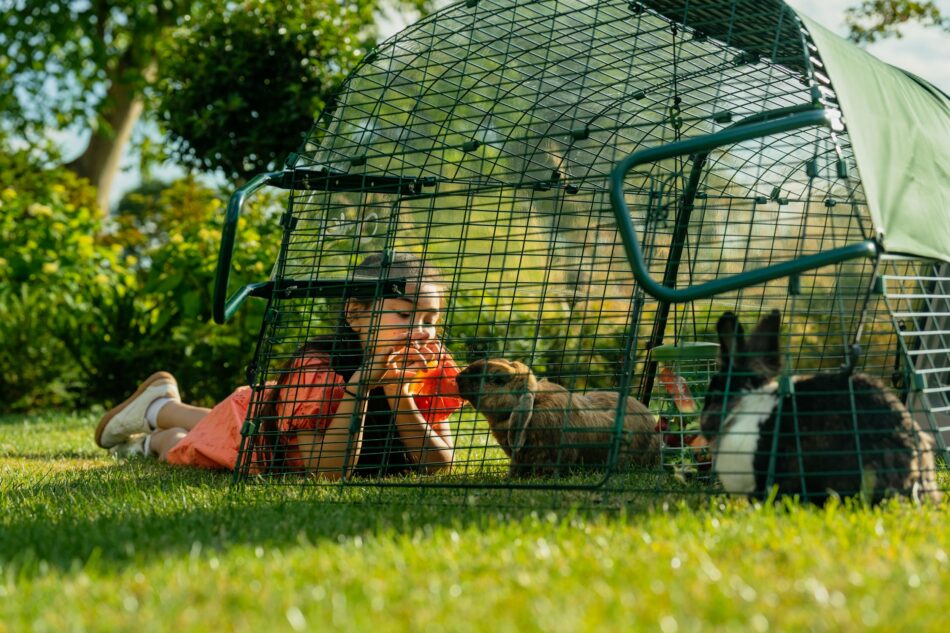 Did you know that rabbits can enjoy a variety of fresh produce? In addition to their dietary staples, bunnies can safely nibble on nutritious garden vegetables and small amounts of fruit. Find out what fresh produce you should be feeding your rabbits, how much, and the benefits of offering them fresh treats.
Did you know that rabbits can enjoy a variety of fresh produce? In addition to their dietary staples, bunnies can safely nibble on nutritious garden vegetables and small amounts of fruit. Find out what fresh produce you should be feeding your rabbits, how much, and the benefits of offering them fresh treats.
What should I feed my bunnies?
First and foremost, rabbits should be fed a quality pellet diet made up mainly of timothy hay. The protein content should fall between 12-16% for most breeds of rabbits, and the fibre content should be at least 15%. Free choice access to loose timothy hay should always be available to help keep their digestion moving smoothly and keep their front teeth trimmed through continuous gnawing. Your rabbits should also have access to fresh, clean water at all times, which thanks to the Eglu Go Rabbit Hutch, is made easy. Simply open the single large door at the back of your rabbits’ enclosure to reveal the bedding tray and access the complimentary hay rack and water bottle.
Anything that’s offered in addition to these dietary staples should be considered treats. Fresh produce is a much healthier alternative to pre-packaged rabbit treats that are commercially available, but should still only be offered a few times a week. Rabbit-safe fruits can also be offered, but in moderation, as they are high in sugar. These foods are not readily available to wild rabbits – and while your domesticated bunnies may have all of their needs provided by you, their digestive system is still very similar to their cousins in the wild. By replicating the diet that rabbits stick to in the wild, you’ll help your pet bunnies maintain a healthy lifestyle.
Rabbit-safe fresh produce
There are several rabbit-safe foods that can be found in grocery stores, home gardens, or even in your own backyard. Fresh produce should be served in a separate feeder than their regular diet to keep their run clean. A hanging treat holder is perfect for serving up fresh foods to keep them away from insects and to give your rabbits a new angle on snacktime.
Some fresh produce is healthier than others, while some should be avoided entirely. This list isn’t comprehensive, but it includes the most common fresh produce that can be offered to rabbits.
Vegetables
Veggies can be offered several times a week, with a few exceptions. Spinach contains oxalic acid, which in high amounts can cause digestive upset in rabbits. Sweet potatoes are also a favorite among bunnies, but are very starchy, so they should be offered sparingly.
Vegetables that are safe and nutritious for rabbits include:
- Asparagus
- Bell pepper
- Broccoli
- Brussel Sprouts
- Cabbage – red, savoy and kale
- Carrot tops (more on carrots later)
- Cauliflower leaves and stalks
- Celery
- Chicory
- Cucumber
- Lettuce – romaine or green leaf
- Parsnip
- Radish
- Spinach (no more than once a week)
- Sweet potatoes (sparingly)
- Turnips
- Watercress
- Courgette
Carrots – not a rabbit’s best friend
Rabbits are so closely associated with carrots that it’s hard to fathom that they might not actually be that good for them. From Peter Rabbit to Bugs Bunny, fictional rabbits love carrots – and real bunnies love them too. But, carrots are high in sugar and calories, but lack the fibre needed for a rabbit to digest them properly. A carrot-heavy diet can cause constipation in rabbits, and make blood sugar levels rise dangerously. Carrots should be fed as fruits are – fine as an occasional treat, but only offered in moderation.
Fruits
Fruit should be offered in small amounts, no more than 1-2 times per week. Don’t offer fruit to rabbits less than 7 months of age, as their young digestive system may be upset by the sugar content.
Rabbit-friendly fruits include:
- Apples
- Bananas
- Berries – Blueberries, blackberries, raspberries, and strawberries
- Kiwi
- Melon (without the rind) – cantaloupe, watermelon and honeydew
- Pears
- Tomatoes
Herbs and plants
Wild rabbits eat a wide variety of plants, and even wood and bark. There are many forage plants that you can feed your pet rabbits, but not all native fauna is fair game. Never offer a wild plant to your rabbits unless you’re confident in identifying safe types. And, always make sure that wild plants haven’t been sprayed with fertilizers or pesticides – most of which are harmful or even fatal to rabbits.
Herbs and plants that are safe for rabbits include:
- Basil
- Berry leaves – blackberry, raspberry and strawberry
- Clover
- Dandelions – flowers and stems
- Dill
- Grass – fresh stalks, not lawn clippings that may contain other plant matter
- Mint
- Oregano
- Parsley
- Plantain
- Rose – leaves, petals, and stalks
- Rosemary
- Sunflowers
- Yarrow
Dangerous plants and vegetables
Some fresh foods are bad for bunnies. These plants affect your rabbits in many ways, ranging from mild discomfort to being toxic even in small amounts. If you suspect your rabbit has eaten any of the following, keep a close eye on them and call your veterinarian if you notice any unusual behaviour.
Never feed your rabbits:
- Aubergines
- Avocados
- Bamboo shoots
- Beans
- Chives
- Garlic
- Iceberg lettuce
- Nuts
- Onion
- Peas
- Potatoes (sweet potatoes are fine)
- Rhubarb
- Tomato leaves (in large quantities)
Feeding your rabbits with Omlet
Finding fresh produce for your rabbits is a fun way to diversify their diet and deepen your bond with them. Offering their fresh foods in a Caddi Rabbit Treat Holder keeps their rabbit hutch and run clean and reduces potential waste. Or, build your bunnies a custom burrow with our Zippi Rabbit Tunnel System and strategically place their snacks along the way. However you choose to treat your pets, we’re here to support your rabbits’ healthy habits.
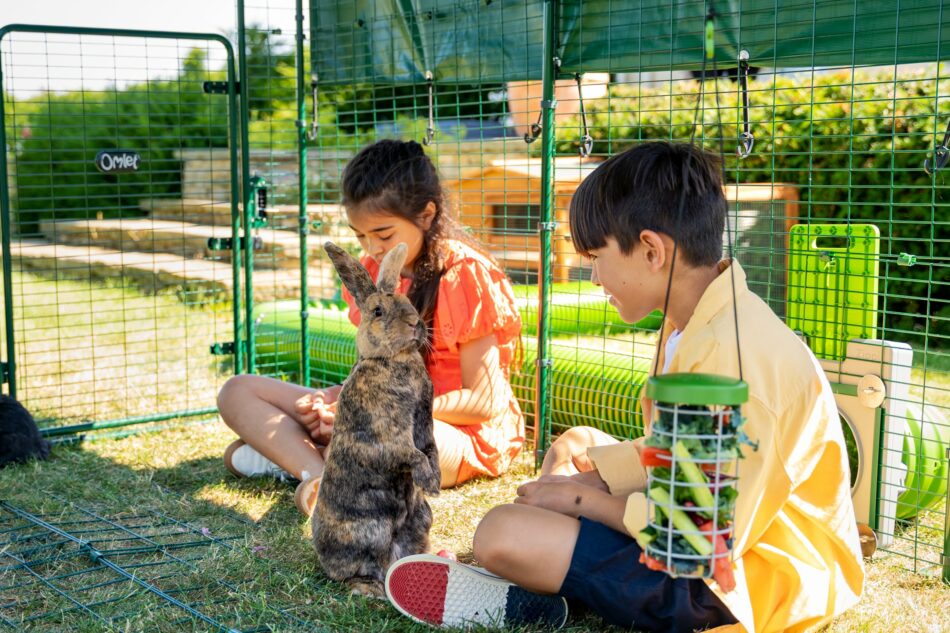
This entry was posted in Rabbits
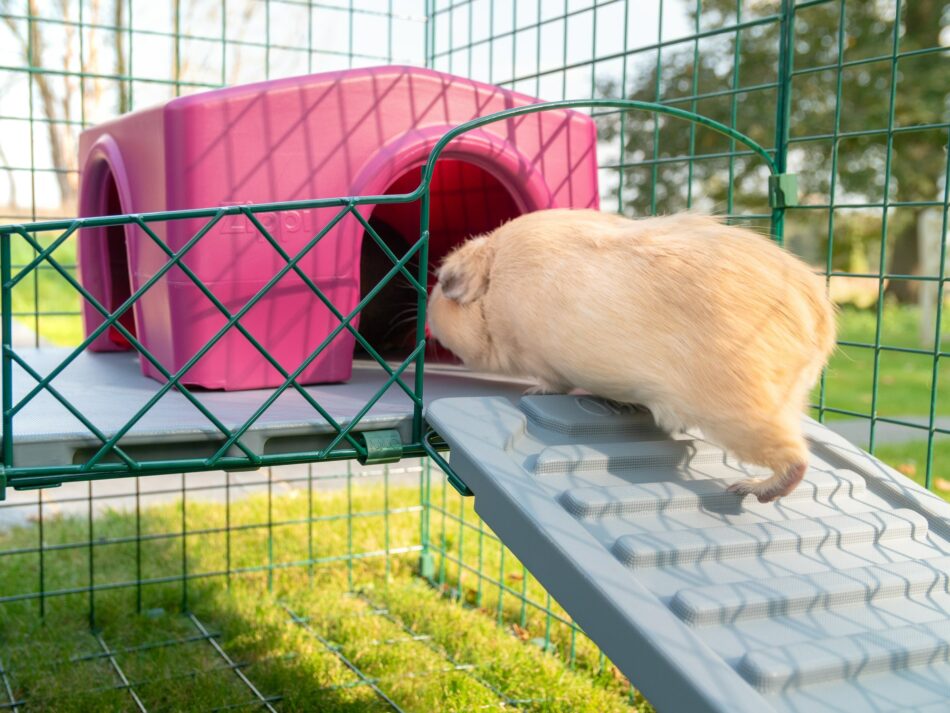
Rabbits and guinea pigs need exercise – and lots of it. Bunnies and cavies can become bored quickly without enough physical and mental stimulation, and a lack of activity can create these small pets to gain an unhealthy amount of weight. Adding levels to your rabbit or guinea pig’s enclosure through the use of platforms encourages more exercise and builds strength.
Physical and mental well-being
Exercise is important to rabbits and guinea pigs to keep them both physically and mentally fit. Keeping small animals at an appropriate weight is essential to their longevity. Accomplished through a balanced diet and plenty of space to be active, a rabbit or guinea pig kept at a healthy weight will remain active far longer than their overweight counterparts.
Omlet’s Zippi Platforms for rabbits and guinea pigs are designed to add extra space to your pet’s run. More space in their enclosure offers more opportunities for enriching activities and accessories. Teach your bunny or cavy new tricks on their platform to further stimulate their critical thinking skills.
Prevent the risk of injury and obesity
Rabbits and guinea pigs that spend the majority of their time in their enclosures aren’t able to exercise as much as their cousins in the wild. Wild cavies and hares run long distances, burrow, scurry, and don’t have constant access to food. Our pets that descended from these wild animals have slower metabolisms as a result of breeding and circumstance and rely on care from their owners to remain fit and healthy.
The use of ramps to access Zippi Platforms strengthens muscles and offers mental stimulation. Our platforms can be easily repositioned for rabbits especially to add more height. By exercising at an incline, your rabbit or guinea pig will utilize their muscles in ways that a one-dimensional enclosure can’t offer.
Overweight pets are prone to joint pain, health issues such as diabetes or other metabolic diseases, and decreased lifespan. Regular veterinary checkups can help you determine if your rabbit or guinea pig is receiving adequate nutrition and exercise. You can also do a quick check at home to see if your pet is overweight by gently pressing along the sides of your rabbit or guinea pig’s abdomen. Can you feel their ribs? You should be able to feel the distinct ridges of your pet’s ribcage without having to press too firmly. If you can’t feel their ribs, they’re likely overweight.
Along with exercise, diet is critical in keeping your rabbit or guinea pig healthy. Offer high-quality pellets that are timothy hay-based, and offer free-choice loose timothy hay or orchard grass. Treats should be given sparingly, and should consist of fresh greens rather than store-bought treats. Other guinea pig and rabbit-safe treats can be offered, but are best utilized during training sessions or other special occasions.
Platforms: a multitude of possibilities
Rabbits and guinea pigs grow bored easily in their surroundings. By adding platforms to their run, the topography of their environment can be changed regularly. Try feeding them on their platform one week, and below the platform another week. You can also place their favourite bed or toy at the top of the platform to encourage climbing up and down the ramp.
Small pets are also prey animals, which means they appreciate a higher vantage point. Your guinea pig or rabbit will appreciate the opportunity to scamper and scurry to the top of their platform to get a new look at their world.
Create the ultimate playspace for your rabbit or guinea pig. Omlet’s Zippi Platforms can be easily adjusted to a height that accommodates your pet’s personality and skill level. They can also be repositioned easily around the run to change up your bunny or cavy’s enclosure regularly. Our non-slip design builds confidence in your pets, allowing them to navigate the ramps and platforms with ease.
An easy way to have fun together
An elevated space in your rabbit or guinea pig’s run gives you a chance to interact with them on a higher level – literally! Sit with them at eye level, train on a flat and accessible surface, and customize their run with the use of Zippi Platforms. A designated training space will help you train your rabbit or guinea pig to perform tricks, giving you a clear, easily accessible area to work with your pet.
The first training opportunity you’ll find with your rabbit or guinea pig is getting them comfortable with their ramp and platform. Offer your rabbit or guinea pig’s favourite treats in a Caddi Guinea Pig or Rabbit Treat Holder placed at the top of the ramp. This will be the easiest way to help your pet get the hang of going up to the platform – especially if they are food-motivated. Once they are comfortable using their ramp and platform, you can begin teaching your rabbit or guinea pig additional skills.
Omlet and your small pets
Omlet is dedicated to designing products that thrill both pets and their owners. From unique rabbit and guinea pig shelters, to our customizable and versatile Zippi Tunnel System, we’ve got what you need to create the ultimate experience for your small pets. Foster your rabbit or guinea pig’s natural instincts while providing a visually stunning enclosure to enjoy in your yard or garden. With Omlet, owning and caring for your pets has never been easier.
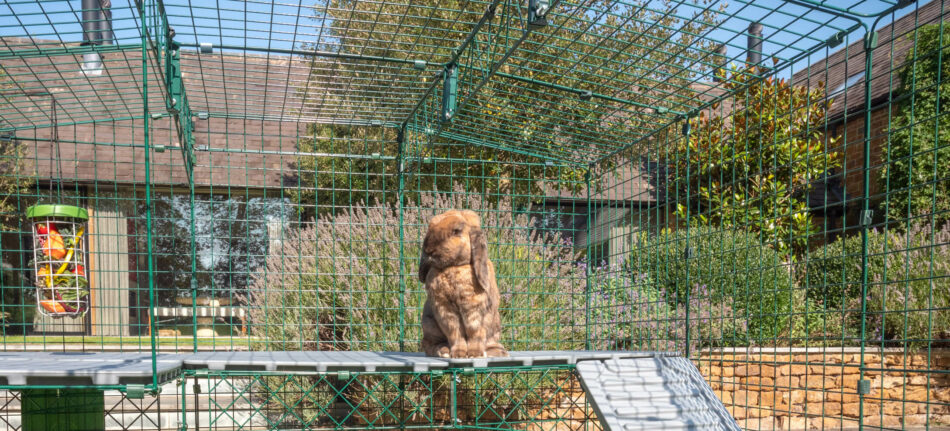
This entry was posted in Guinea Pigs
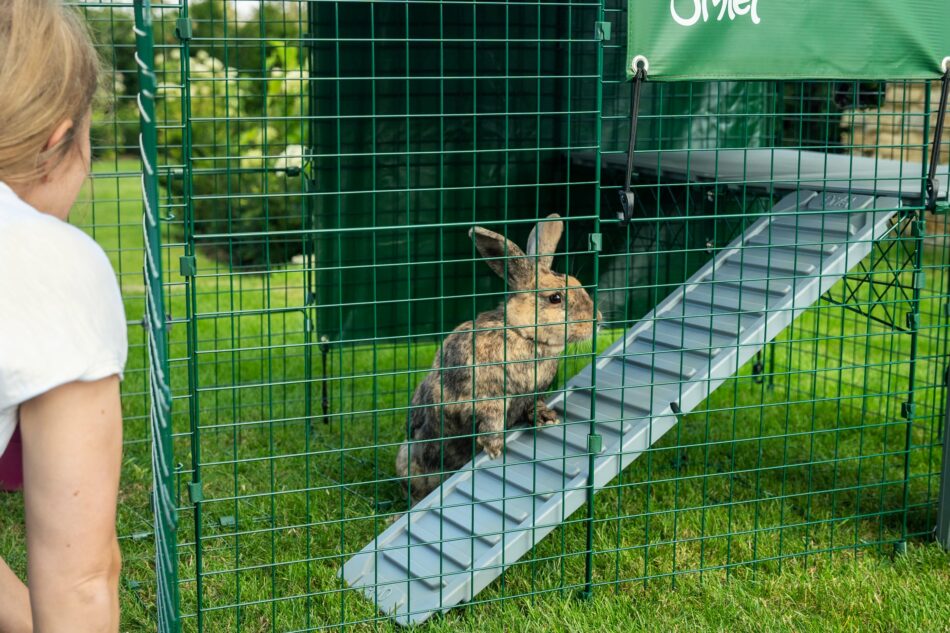
Compared to a one-level play area, having an additional floor height in your rabbits’ enclosure boosts exercise opportunities, helping your rabbit activate muscles that they would use in their natural environment to climb up and down underground mazes and burrows. Jumping on and off a platform helps to keep muscles and bones strong, which is why platforms are recommended as an essential rabbit accessory by vets and pet charities. So how do you use Omlet’s Zippi Platforms with your rabbits?
What are the Zippi Platforms from Omlet?
The Zippi Rabbit Runs and Platforms from Omlet are designed to offer a modular system that you can adapt at any time. The platforms fit securely to the Zippi rabbit enclosure, so they feel safe underfoot and are waterproof so they’re easy to clean with just a garden hose and pet-safe disinfectant. Start small, and add more extensions and platforms at any time to build an amazing play area for your rabbits.
How can I give my rabbits more space?
Platforms are also an easy way of giving your rabbits more space to move around and explore. By positioning a platform in your rabbit’s enclosure, you can make better use of the height to give an even bigger area for toys and exercise. The platform gives a look out for rabbits to examine their environment from a height, plus a more exhilarating way to exercise. The area beneath feels safe for rabbits to relax and graze on hay, or if they need to shelter from bad weather.
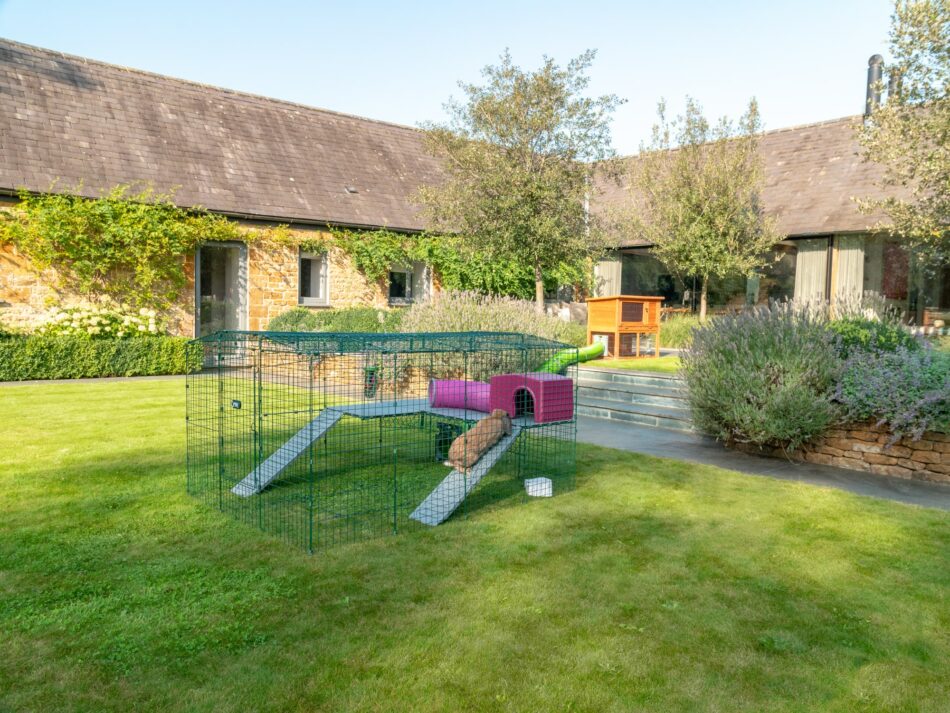
5 ways to use the Zippi Rabbit Platforms
Need some inspiration on how you can use platforms with your pet? Take a look at our ideas below to create a fun and safe area for your rabbits to exercise.
1. Take shelter to new heights
The Zippi Platforms offer shelter below for bad weather days, but your rabbits can still make the most of the second level in their enclosure during wind and rain, with the Zippi Shelters and Play Tunnels.
With a 3-panel wide rabbit platform, you can even position a Zippi Shelter at either end and connect them together with a Play Tunnel. Or position one Shelter on the platform and one below. Don’t forget to pop some hay inside the Shelter on the platform so your rabbits can nibble away on a snack while they wait for the storm to pass.
2. L-shape suite
The Zippi Corner Platform for rabbits with a multi-panel platform pack can be used to create an L-shaped mezzanine area with 2 ramps. Depending on the length and width of your Zippi enclosure you can either position both ramps in the same direction or create a slight spiral effect.
Here we have used a Corner Platform for rabbits, attached to a Zippi Platforms 3-panel pack, in a 3 x 3 double-height Zippi Run.
3. Down and straight back up!
In a longer Zippi run, around 4 or 5 panels in length, you can position Zippi Platforms opposite each other so your rabbits can run straight down one ramp, and back up another for a loop-the-loop circuit. Don’t forget the Zippi Platforms are strong and sturdy so your rabbit will feel safe to jump and hop up and down the ramp.
4. Lunch on the balcony, sir?
Position Caddi Treat Holders to hang over the platforms so your rabbits can enjoy their lunch with a garden view. Mix up the ingredients in the slow-release feeder to keep rabbits excited, and ensure a 5-star rating for your new bunny bar! These feed toys can also be used as a hay rack to keep the floor of your rabbits’ house or play area clean.
5. Zippi Tunnel to the first floor
Combine the Zippi Platforms with our popular Zippi Rabbit Tunnel System by positioning your Zippi Tunnel entrance up on the platform level. This means your rabbits can hop up and down the Zippi Tunnel to get from one enclosure to their platforms, down the ramp and into another Zippi Run.
You can use the Zippi Platforms with a Zippi Tunnel Twin Pack with Hutch to Run Connection Kit and Zippi Tunnel Supports to connect a Zippi Run and an Eglu Go Hutch Run. Alternatively, you can connect the tunnels to your wooden rabbit house to another enclosure.
Omlet and your rabbits’ home
As a rabbit owner, it’s your responsibility to provide your rabbits with everything they need, and that includes a safe enclosure, where they can play, exercise, eat, and clean themselves. Providing a range of toys for play and exercise will help keep your rabbit happy and healthy, and with Omlet’s Zippi Platforms along with the Zippi Rabbit Tunnel System and Eglu Go rabbit hutch you can do just that, with a playground they’ll love.
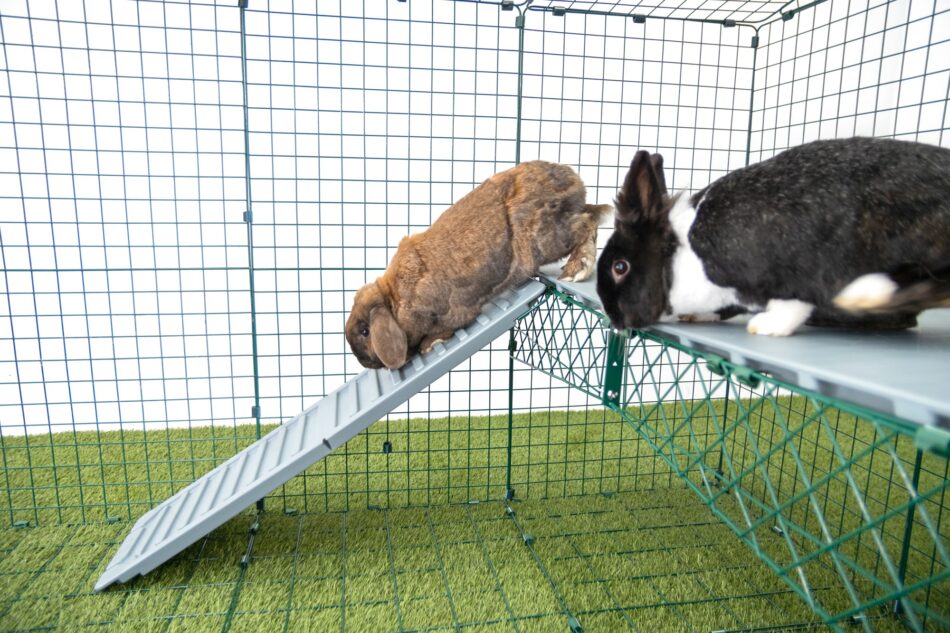

This entry was posted in Rabbits

2 x 2 Outdoor Rabbit Run
Any rabbit owner looking for more space for their pets will be delighted to receive this 2×2 Outdoor Rabbit Run. The run is extremely stable and secure, and can be connected to an existing Eglu Go Hutch with or without run with a simple connection kit.
This is perfect if you, or the person you’re buying a gift for, want to give rabbits or guinea pigs a bit more space to play on in the garden. Choose between the full or low height, both are currently 10% off in the Omlet Winter Sale!
Zippi Tunnels, Play Pens & Runs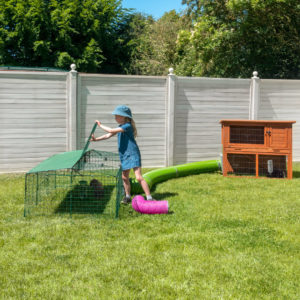
Zippi is the perfect way to enhance your pets’ life. The amazing tunnel system allows you to create a burrow-like path in your garden that your rabbits and guinea pigs will love exploring. Expand with corners and T-junctions, and add intrigue with hayracks and lookout towers!
The Zippi Tunnel System also makes it super easy for your pets to independently move between their hutch and a remote run or playpen, so that they can come and go as they want throughout the day.
This is the perfect opportunity to extend an existing system, or to start a completely new one! All Zippi Tunnel System parts are discounted by 20% in the Winter Sale, and the Zippi Run and Playpens are currently 10% off!
Caddi
The Caddi is the perfect stocking filler for any small animal lover. This interactive treat holder can be hung from the roof of any hutch or run, and can be filled with fresh vegetables or hay for rabbits and guinea pigs to enjoy.
It’s super easy to refill, will keep the pets’ snacks fresher for longer, and they will love the challenge of the swinging Caddi as they go in for a bite!
Save 15% on the Caddi right now!
Click here for full terms and conditions.
This entry was posted in Gift Guides
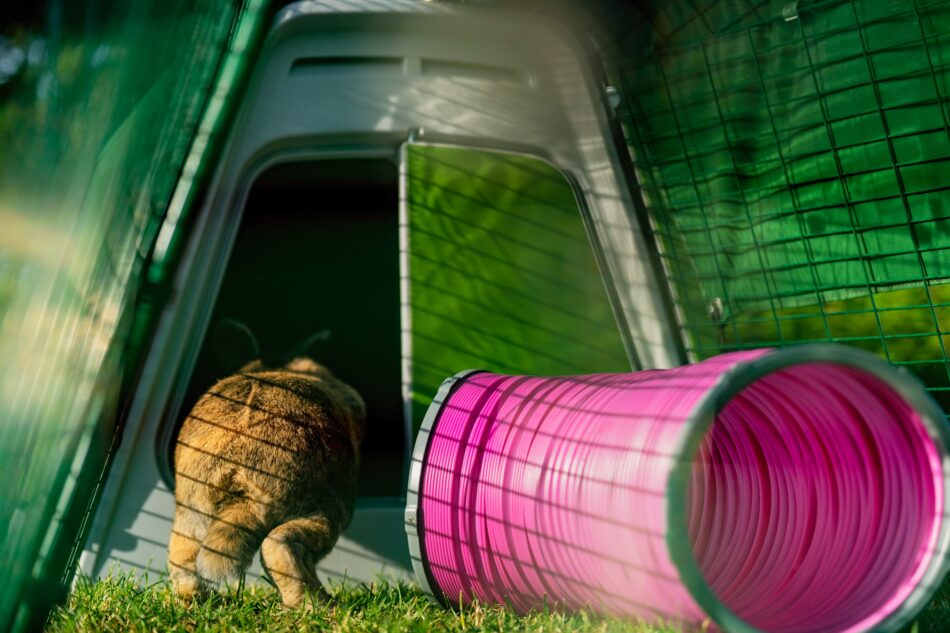
Rabbits make great family pets, and there are many different breeds to choose from. Some are easier to care for than others, making them ideal choices for beginners or children. Other breeds can prove more challenging to care for, but can be enjoyed by more seasoned rabbit-owners. So, which is the best rabbit for you? We’ll outline our top picks.
Children and rabbits
Although they make good pets for kids, rabbits might be disappointing as a first-time pet for young children. This is because most rabbits aren’t fond of being picked up and carried around, and can cause accidental injury to both themselves and children due to their powerful back legs and sharp claws. But, this isn’t to say that rabbits can’t be good pets for children.
Because bunnies need a gentle and practised hand, it’s best for parents or older siblings to be the ones handling them. Younger children can enjoy sitting with, petting, helping feed, and observing pet rabbits, making rabbits good pets for children of all ages.
5 best rabbit breeds to own
We aren’t trying to play favourites, but there are a few rabbit breeds that stand out as ideal choices for first-time rabbit owners. Their overall personalities, low-maintenance grooming needs, and basic housing requirements make these breeds great options for families.
Mini Lops
Big floppy ears, but with a compact, easy-to-house stature, Mini Lops are a favourite among first-time rabbit owners and breeders alike. They have outgoing personalities, and are known for being good with children. Mini Lops have short-medium coats that don’t require much grooming, and top out between 4.5-6 pounds. They’re easily trained and are social with other rabbits and humans.
Holland Lops
Similar to their cousins, Holland Lops have floppy ears and small bodies. Their faces are more flat than Mini Lops, and their ears are shorter and more rounded. Holland Lops weigh 4 pounds or less when they’re full grown, but have lots of energy. They’re social and enjoy interacting with humans and other rabbits, but need plenty of space to exercise. Because of their energetic nature, Holland Lops prefer to play with their owners rather than be carried around — but they’ll enjoy a good snuggle.
Lionheads
As their name suggests, Lionhead rabbits have tufts of hair encircling their heads that appear like a lion’s mane. While they do have extra hair that requires brushing from time to time, Lionheads have small bodies that weigh between 2.5 and 3.5 pounds when full-grown, making them perfect handling size. In fact, Lionheads are known as “lap rabbits”, and actually enjoy being held and handled. Their sweet, laid-back personalities make them a favourite among families.
Himalayans
Himalayan rabbits have a striking appearance — white bodies with dark points and pink eyes. They grow to be between 3 and 5 pounds, and have short hair that is easy to groom. Himalayans have long been appreciated for their calm and patient personalities. They don’t mind being handled, and are one of the oldest domesticated breeds of rabbits, making them well accustomed to human interaction. Himalayans are easy to train and care for.
Harlequins
A medium breed weighing up to 9 pounds, Harlequin rabbits are stunning in appearance and are curious and outgoing. They love learning tricks, and respond to praise from their owners. Harlequin rabbits should have plenty of space to expend their energy, and thrive off of human interaction. Their size may make them slightly more difficult for children to handle, but their desire to please makes it easy to train them to come when called and accept being petted and held.
Basic bunny care
No matter which breed you choose, all rabbits have the same basic needs. Before bringing your rabbit home, be sure to have:
All rabbit breeds thrive best when they’re given as much space to play and explore as possible. The addition of Zippi Rabbit Tunnels and Zippi Rabbit Playpens broadens your bunnies’ territory and fosters their natural desire to burrow, scurry, and play.
Bunnies need buddies
In addition to their housing, rabbits need companionship. Two neutered males, a neutered male with a female, or two females are all successful combinations. The younger the rabbit, the easier it will be for them to bond with another bunny, but it’s possible to introduce two grown rabbits for a lasting relationship. Rabbits are social animals, and their interactions with each other won’t interfere with the bonds made with their humans.
Consider adopting a bonded pair of rabbits, or obtaining two young rabbits at the same time when starting out. A lonely rabbit may become depressed or act out, so providing your bunny with a buddy will make it easier for you to build a bond with them.
Omlet and your rabbits
Building bonds between you and your bunnies is at the forefront of our designs. Our Eglu Go Rabbit Hutch has everything you and your rabbits need to keep them safe and happy, while our line of Zippi Rabbit Tunnels and Zippi Rabbit Playpens enable you to watch and play with your rabbits in an environment that mimics nature — making your relationship with them as unique as their individual personalities.

This entry was posted in Rabbits
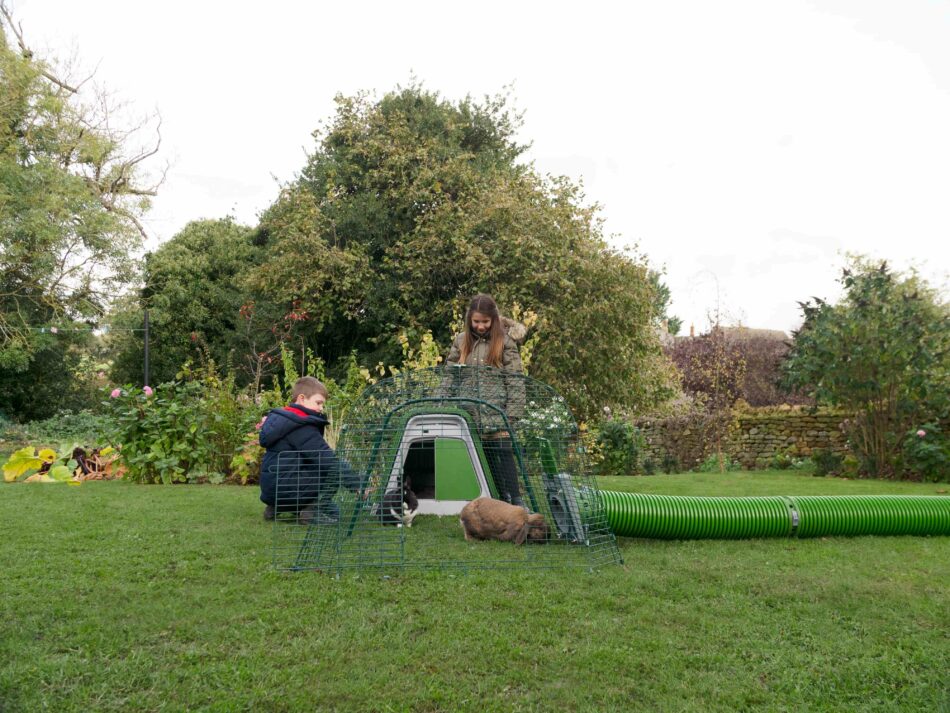 We often get questions about whether rabbits will be okay outside in the winter. The simple answer is: yes. But things get a little more complicated when you consider the specific climate, individual rabbits, and their setups. We’ll share how you can safely keep your outdoor rabbits outside during the winter, and how to determine if and when it’s time to bring them inside.
We often get questions about whether rabbits will be okay outside in the winter. The simple answer is: yes. But things get a little more complicated when you consider the specific climate, individual rabbits, and their setups. We’ll share how you can safely keep your outdoor rabbits outside during the winter, and how to determine if and when it’s time to bring them inside.
Can rabbits live outside during the winter months?
Rabbits that are accustomed to living outdoors are well-equipped to handle the winter months. At this point in the year, you’ve probably noticed your outdoor rabbits’ fur looking mottled due to a process called moulting. Moulting in rabbits is a natural process that prepares their coats for the winter months ahead, and is triggered by the amount of daylight. So, if your rabbit is outdoors during summer and fall, the dwindling daylight hours signal them to start shedding their thinner summer coat in order to regrow a more dense coat for the winter.
Once they’ve donned their winter coats, your rabbits can withstand the colder outdoor temperatures quite well. In fact, rabbits are much more comfortable in the cold than they are in the heat. But, in order for their natural insulating layers to be effective, bunnies need dry, clean areas to shelter in.
In the wild, rabbits will warm up in underground warrens, or burrows, and huddle together for warmth. Domesticated rabbits need a similar environment – a draft-free, dry hutch to warm up in. The Eglu Go Rabbit Hutch was designed with this in mind. The twin-insulated walls offer protection from drafts while containing the natural body heat of your rabbits within. And, our hutch is designed to provide ample ventilation to prevent moisture buildup, which is especially important during the winter months.
But will they be happier inside?
It may be tempting to bring your outdoor rabbits inside for the winter, but the trouble with this is threefold:
- Bringing your bunnies inside for more than brief visits acclimates them to your home’s interior temperature. This makes it more difficult to move them back outside without shocking their system.
- The artificial lighting in your home will disrupt their biological clock, which may cause them to shed their winter coat too early.
- They will need indoor accommodations away from the hustle and bustle of your home activities. Rabbits may become stressed by stimuli such as televisions, radios, children playing, or other loud noises – especially around the holidays.
Rabbits that are well adjusted to their conditions and schedules outside will thrive much better staying in their home all year round – including during the winter. If your rabbits have lived outside for the rest of the year, save for a couple of caveats.
How cold is too cold for rabbits?
Rabbits don’t adhere to a particular rule when it comes to temperatures. What is true for most bunnies might not apply to others. Observe your bunnies as well as the weather in order to gauge how cold is too cold for your rabbits. If temperatures have been gradually declining over several weeks, your rabbits’ coats should be sufficient to keep them warm enough in even sub-zero temperatures. But, here is where the first caveat of bringing your bunnies inside comes in:
- If the temperatures have been mild for weeks, and your area experiences a sudden and brief cold snap, you may want to consider bringing your rabbit indoors.
This is because a rapid and temporary drop in temperature can be too much for a rabbit that hasn’t finished growing its winter coat. However, the addition of extreme temperature protection on your rabbits’ hutch is enough to bolster your bunnies through a quick cold spell. You can also move your rabbits to a sunnier area of your garden, or under the shelter of a garage or shed in the event of freezing precipitation.
The other caveat to leaving your bunnies outdoors is their health:
- Older rabbits, or those with health conditions that may affect their coats or metabolisms should spend seasons with extreme temperatures indoors.
They don’t have to miss out on all the fun though. Rabbit runs and playpens can be utilised both indoors and outdoors to create safe spaces. On mild winter days, your rabbits will appreciate a romp outside in the sunshine.
What can I do to help my rabbits in winter?
This advice applies if you keep rabbits in an outdoor rabbit hutch and run. If you’re moving your pets inside you won’t have to worry too much about protecting them from bad weather.
Regularly checking in on your rabbits is one of the best ways to ensure they’re in good health, and give you an idea of how well they’re handling the weather. But, there are some other ways you can help your rabbits through the winter.
Exercise
Exercise helps ramp up your rabbits’ metabolisms to help keep them warm during the winter. Make sure they have plenty of space and opportunity to stretch their legs and generate heat. Connecting their hutch to a Zippi Rabbit Playpen via our Zippi Rabbit Tunnel System gives them plenty of room to burrow, explore, and play.
Location
Keep your rabbits’ hutch in a place that receives as much sun during the day. Use clear rabbit run covers during the winter months to allow warming rays of sunshine in for your rabbits to stretch out. If your area receives a lot of snowfall, the addition of wheels and handles to your rabbit hutch allows for quick and easy movement to shelter or shovelled areas.
Bedding
You’ll find your rabbits spending more time in their hutch during the winter due to both decreased daylight hours and temperatures. Make sure to change their bedding frequently to keep them clean and dry. Choose a thick bedding like straw and provide a thick layer for your bunnies to burrow into.
Diet
Your rabbits should have unlimited access to timothy hay all year round, as well as a serving of quality pellets daily. To stoke their metabolisms during the winter, gradually add in alfalfa hay or pellets into their diet to provide extra energy. Other treats like leafy greens can be served in a Caddi Rabbit Treat Holder to keep it up off of the frozen ground.
You’ll also want to switch to a crock or bowl for their water during the winter months to prevent bottles from breaking in freezing temperatures. A bird bath heater or plug-in heated pet water bowl can be used to keep their water thawed – just be sure that the cords are not within your rabbits’ nibbling range.
Your outdoor rabbits with Omlet
Don’t stress over your rabbits during the colder weather. With our Eglu Go Rabbit Hutch, Zippi Rabbit Runs and Playpens, and Zippi Tunnel System, you can create a winter wonderland that both you and your rabbits can enjoy. With dry, insulated dwellings, your bunnies will boldly take on the chilly temperatures – and you will rest assured knowing they’re comfortable and happy not just during this season, but all year round.
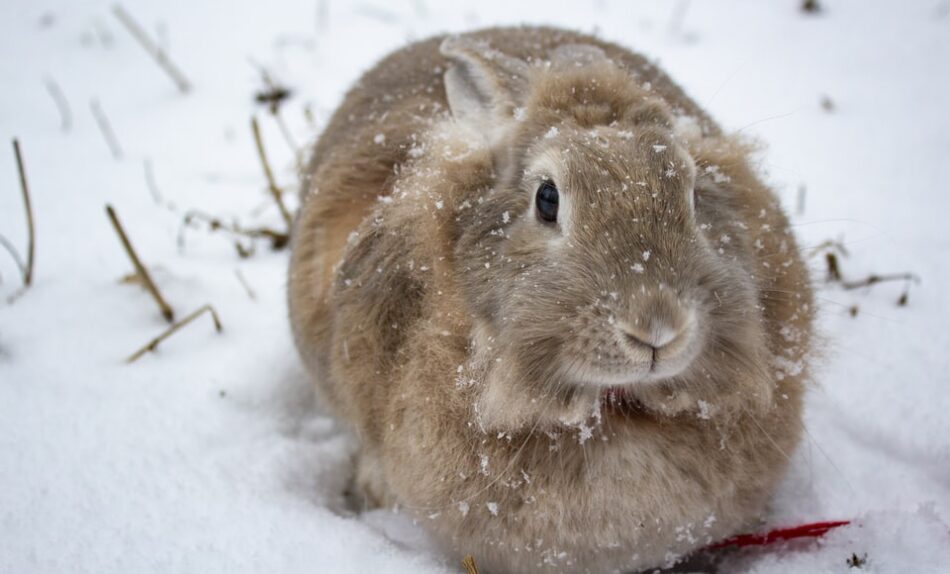
This entry was posted in Rabbits
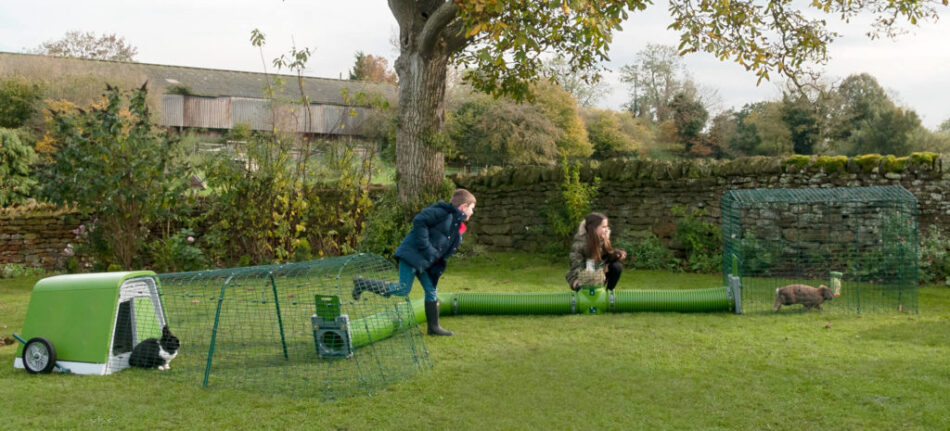
Autumn is the perfect opportunity to take some time to make sure your bunnies are happy with their setup in the garden. After a scorching summer, the more comfortable temperatures of autumn will be warmly welcomed by us and our floppy-eared friends. The change in season brings a cooler breeze, beautiful crisp leaves, and plenty more exciting sights and smells for bunnies to explore around their homes. Before the real winter chill hits, now is the perfect time to upgrade your rabbit run. So, how exactly can you transform your pet’s summer hideaway to a cosy rabbit retreat?
Extensions
First of all, take a good look at your run and assess if it is good enough for your beloved bunnies, or if there is room for improvement. Whether they have an Eglu Run, Outdoor Rabbit Run or Zippi Run, you can make it larger with practical and easily assembled extension panels. That way your bunnies have more space to run around on, and you can add more fun accessories that will keep them busy in the colder months.
Caddi
Leftover food and treats lying around the run not only makes it look a bit sad and untidy, it can also attract rodents and other pests, and if you’re not vigilant with your cleaning your rabbits might accidentally ingest something that has gone mouldy.
A great way of upgrading your run, and feeding your pets yummy and nutritious treats, is to get a Caddi Treat Holder. Fill it with fresh grass, allotment veg or some chopped up fruit, and hang from the top of the run. The rabbits will love the swinging motion of the holder as they try to grab a delicious mouthful, and the spillage will be minimal. Additionally, you will be able to keep track of when you gave your rabbits which treats, so you can alternate between different ones and make sure nothing that has gone off is still in the run.
Platforms
Everyone knows that rabbits love to hop! Adding platforms to your rabbit’s run is a great way to let your rabbit bounce to their heart’s content, whilst you make the most of the usable space that you have in their Zippi Run. Platforms will provide your fluffy friend with more places to explore, which in turn will help to strengthen their muscles as they jump up and down on their new adventure playground. The Omlet platforms are also suitable for use all year round, so you can still get the most out of this feature for when the weather gets cooler over autumn.
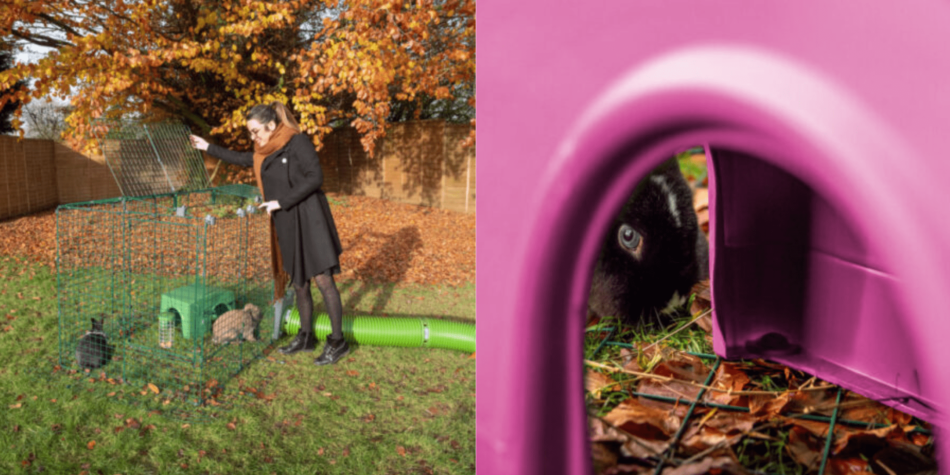
Shelters
The Zippi Shelters will be a great addition to your run this autumn, as they provide both (surprise surprise) shelter and an invitation to stimulating play. Rabbits have a natural instinct to seek a hidey hole, and in the wild they create ‘rooms’ in their warrens where they can come to relax and have a nap. The Zippi Shelters will provide exactly this, but in your pet rabbits’ run. They will also love running in and out of, or jumping on top of the Shelter to survey their surroundings.
Although the rabbits will always have their hutch to retreat to when it gets wet or windy, it’s great to have another spot where they can get away from the inevitable autumn showers. The shelters are sturdy and waterproof, and your rabbits will love hopping in to relax.
Treats
As it gets colder your rabbits will use more energy to stay warm, so it’s the ideal time to stock up on treats for the cupboard. Make sure you find a good balance between fresh fruit and veg and shop bought treats to put on the run, like these Nettle and Dandelion roots that are full of vitamins and minerals, or the Beaphar Crunch Sticks that encourage healthy dental wear.
For more inspiration and ideas on how you can improve your rabbit’s autumn setup, take a read of our 8 Tips for Making Your Pets’ Run More Fun This Autumn blog. And to make sure your bunny has everything they need to make this special season amazing, discover everything the Omlet Rabbit Shop has to offer.
This entry was posted in Rabbits

Here’s why the Caddi is the perfect choice for your treat-loving pets…
- The Caddi Treat Holder decreases the rate at which your pets will eat their treats. Slower treat release through the gaps in the holder means more satisfaction for longer, and prevents over indulgence.
- The Caddi Treat Holder swings around and creates a rewarding, interactive game to keep your pets entertained, which is especially great for rainy days! Your pets will love the stimulating experience of foraging for their treats, and enjoy hours of rewarding fun.
- The Caddi allows you to feed your pets treats without having to throw them on the ground. This improves run cleanliness, reduces food waste and prevents pests, as well as being a healthier solution for your pets. Simply hang the Caddi from the roof of your pet’s run with the plastic hook and use the string to adjust the height to suit your pets.
- Endless treat opportunities! With the Caddi Treat Holder you can feed a range of fresh greens, fruits and vegetables to your pets, you can use it as a hay rack for rabbits, or fill it with pecker balls for hens. Get creative and reward your pets with exciting new flavours in the Caddi.
- You can save 50% on the Caddi Treat Holder until midnight on Monday, just by signing up to the Omlet newsletter. It’s a great deal for you, and an exciting new treat dispenser for your pets! Enter your email address on the Caddi page to claim your discount code.
Now available for just £4.99 if you sign up to the Omlet newsletter!

Terms and conditions
This promotion is only valid from 12/08/20 – midnight on 17/08/20. Once you have entered your email address on the website you will receive a unique discount code that can be used at checkout. By entering your email you agree to receive the Omlet Newsletter. You can unsubscribe at any point. This offer is available on single Caddi Treat Holders only. The offer does not apply to Twin Packs or bundles with Omlet Peck Toys or Feldy Chicken Pecker Balls. Offer is limited to 2 Caddi Treat Holders per household. Subject to availability. Omlet ltd. reserves the right to withdraw the offer at any point. Offer cannot be used on delivery, existing discounts or in conjunction with any other offer.
This entry was posted in Chickens
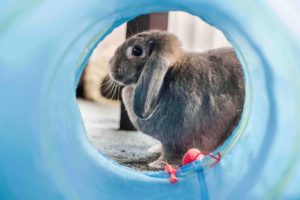
Rabbit owners often ask us if pet bunnies can swim. The answer is yes – but in many ways, it’s the wrong question. If you ask “Do rabbits enjoy swimming?”, the answer is definitely no.
Most mammals are capable of swimming, but not many actually take a dip unless they are forced to. We all know that cats hate water – but they can and will swim for safety if they have to. Rabbits are the same. In times of flood, or if chased by predators, they will sometimes jump in at the deep end and swim for it.
Which brings us to one of many rabbit myths. Bunnies have webbed feet – surely a sign of an animal intended for swimming? Well, no. The webbed feet are there to help rabbits hop and run – not swim.
What about all those swimming bunnies on YouTube?
A quick YouTube search will produce a list of video clips showing bunnies apparently enjoying themselves in garden pools; but you will struggle to find a clip in which the rabbit voluntarily enters the water. Some can be trained to do so, in the same way as a circus can train animals to do all sorts of things they wouldn’t otherwise choose to do. And that’s the main point – turning your pet rabbit into a circus act is inhumane.
In the various videos of swimming rabbits, the animals don’t appear panicked or distressed. But that’s just the rabbit’s way of surviving. It knows it can float, and it knows it can paddle to safety. It’s not going to thrash around and drown, and nor is it going to give any clues to how it’s feeling in its facial expressions. A rabbit serenely gliding across a garden pool is doing one thing only – surviving.
This has become a contentious issue, and there are even online petitions to prevent swimming bunny videos being posted online. As far as the signatories of the petitions are concerned, this is animal cruelty, nothing more and nothing less.
Healthy Swimming for Rabbits?
There is circumstantial evidence that some rabbits like to float in the water to ease arthritic problems, or simply to clean themselves and/or cool off. The only advice that can be given here – after taking such evidence with a pinch of salt – is to let the rabbit lead the way. A bunny who voluntarily takes a dip does not necessarily need dragging from the water and locking away somewhere dry and safe. The swimming is, no doubt, great exercise, just as it is for humans.
However, the fact that a rabbit enters the water may indicate an underlying problem – perhaps they do, indeed, have joint problems, or maybe their enclosure has an outbreak of fleas, lice or mites, something that might lead a bunny to desperate measures in the garden pool!
And the fact that it’s a garden pool presents another potential problem. Pools tend to have chlorine and other chemicals in the water, and these can irritate a rabbit’s eyes, nostrils and skin. Even untreated water can cause skin irritation if a rabbit remains wet for too long. Rabbits have very small lungs, too, and even a small amount of water breathed in by mistake can prove fatal.
If your pet rabbits voluntarily take to the water, dry them thoroughly after they’ve finished exercising. If you’re considering aquatherapy for rabbit joint-related problems, speak to a vet first.
The rule of thumb on this issue is simple – don’t put rabbits into pools or other bodies of water. Yes, they can swim; but no, they don’t like it. Usually!
This entry was posted in Rabbits
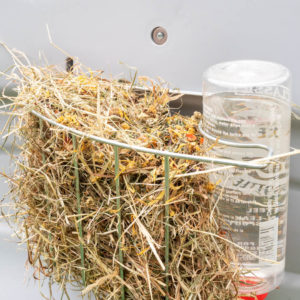
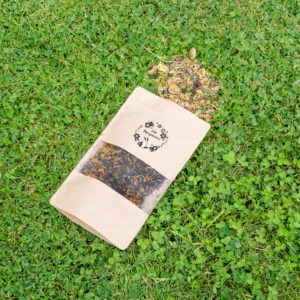
Omlet’s new herbal Pet-Pourri is the perfect way to treat your pet rabbits. The carefully selected blend of herbs and flowers will make the hutch smell lovely and fresh when mixed in with the bedding or hay.
Rabbits are known to nibble everything that comes in their way, so all ingredients are completely safe in moderate doses. In fact, they are all nutritious and flavoursome, and are thought to have medicinal properties that can support your rabbits’ skin, bones, immune system and respiratory and digestive organs.
Here is a list of the ingredients of Omlet’s Pet-Pourri, with a short introduction to why they might be beneficial to your rabbit!
There is no data to show to what degree these ingredients might be beneficial to rabbits, neither that they will be effective for all individuals. If you think your rabbit is not well, please contact your vet immediately to get help and advice.
Nettle – This green plant is one of the richest sources of chlorophyll around, and is high in iron, sodium and chlorine. Apart from repelling intestinal worms, it can also prevent many contagious diseases, and is said to be useful when your rabbit is battling eczema or arthritis.
Marigold Flower – Marigold can be good for wounds, bruises, ulcers and other skin problems. It also settles an upset rabbit tummy.
Hibiscus Flowers – Contains large amounts of antioxidants, and is a great source of vitamin C, something rabbits need on a daily basis. It has been shown to help prevent bladder infections as well as constipation.
Dandelion Leaf – This weed is quite the superfood for rabbits! It is said to help with respiratory ailments and bladder infections, is anti-inflammatory and can stop diarrhea. It is also recommended to give dandelion to a doe just after she’s had a litter, as it stimulates milk flow.
Chamomile Flower – Chamomile is a great treat for a nervous rabbit, as it is believed to have a calming effect, and can also work to help relieve pain. Made into an infusion with water it is great for washing weepy eyes.
Dried Carrot – Carrots are high in fibre, calcium and vitamin A, and will be a great treat for your pet.
Parsley – Apart from being flavoursome and crunchy, parsley enriches the blood and helps treat urinary problems. It has anti-inflammatory properties for the bladder and kidneys, and can help boost fertility.
Peppermint – Mint is said to be good for colds and eye infections, and can have a relaxing effect on the digestive tract, which is useful for problems with indigestion.
Basil – Some say this herb has cancer-preventing properties, and is believed to be good for problems with joints and muscles.
Fennel Seeds – Fennel is used to boost milk production for nursing does, and is thought to help calm a bloated stomach.
This entry was posted in Rabbits
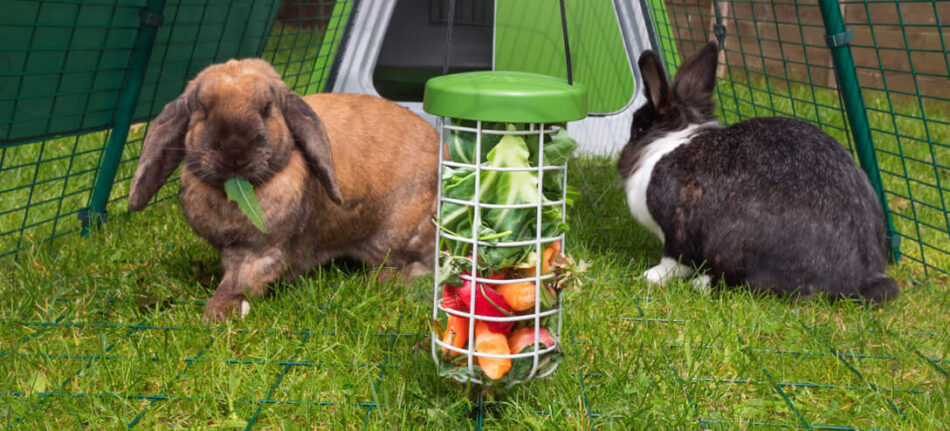
Some pets are pretty obvious with the way they show love and affection. A dog might be the best example of this; with a wagging tail, smiling face and licking tongue, dog owners rarely have to guess if their dog is excited to see them when they get back from work in the evening.
With rabbits it’s a bit more complicated. First of all, it often requires a bit more work to get your pet rabbit to trust you. As prey animals, they are naturally shy and cautious, and it may take a while before they warm up to new people. However, once they know you and trust you, they are extremely affectionate animals that love spending time with their owners. They might just have slightly different ways of showing it!
If your rabbits do all or some of the following things, you can be sure that they feel genuine affection for you.
They stop being nervous
When the rabbit is new to you, it’s normal that they seem skittish or jumpy. This is to be expected, and it may take a while before the rabbit realises that they are safe in their new home.
The first signs that your rabbit is warming up to you is that they stop some obvious nervous behaviours. Maybe they no longer jump back when you reach your hand towards them with some treats, stop running into the hutch whenever you approach or start to relax their body language. These may seem like small things, but they are steps towards your bunny feeling true love for you.
They groom you
When two rabbits live together, they lick, nibble and groom each other as a way of showing love and affection. If your rabbit likes you, he or she might start to lick you or your clothing, nudge your arm or nibble on your finger. This is a sign that you are seen as part of the rabbit’s family, and that they care about your health and cleanliness.
They want to be stroked
If you rabbit comes up to you and starts pushing their head against your hand or put their head on your arm it’s a sign that they love you and want to spend time with you. It means your rabbit trusts you know what you’re doing and won’t hurt them, and is a true signal that they love being around you.
They come and lay next to you
A rabbit that approaches you while you’re spending time with them in their run and lays down next to you is showing extreme trust, especially if they’ve got their legs sprawled out under them. This is a very vulnerable position to be in, so it’s clear that your rabbit trusts that you will look after them.
They run around your feet
The closest you will probably get to a dog jumping up to greet you when you get through the door is your rabbit running in circles around your feet, sometimes doing figures of eight between your legs. You might have seen this behaviour when you approach your rabbits with food or yummy treats, but many will also do it just out of excitement of seeing their favourite human.
They purr
Although it’s actually not purring in the same way as cats purr, but a grinding of the teeth that makes a soft humming sound and causes the rabbit’s head to vibrate slightly, it’s a clear sign that your rabbit is content. Normally this occurs when you’re stroking or grooming your rabbit, a time when your pet doesn’t have to worry about anything.
They do a binky
A binky can be described as a jump up in the air with the legs stretched out. It’s an expression of excitement and exhilaration, and sometimes you will see your rabbit doing this in your company. We dare you not to smile when you see a binky!

This entry was posted in Rabbits
Why should you forage for treats to give your rabbits?
Well, even if there are plenty of great pre-made treats for your pets, it’s sometimes fun to know exactly what you’re giving them. Wild plants are nutritionally balanced, high in fibre and really yummy. Apart from that, they’re also free!
Things to know before foraging for rabbit treats
Before we get going, here are some things to think about:
- If you’re not completely sure that you have identified a plant correctly, don’t pick it. It’s useful to have photos of the plants you’re looking for at hand, and compare what you find with them.
- Try to avoid collecting treats for your rabbits by busy roads with lots of emissions from cars. It’s best to find spots where you’re relatively confident no pesticides or other chemicals have been used, and where cats and dogs will not have peed or pooed on the plants.
- If you want to you can wash your finds when you get home, but in most cases this is not necessary. If you’re introducing something new to your rabbits, start slowly and give only small amounts of the new food at the time. Some treats can upset the rabbits’ very sensitive stomachs. Also remember to only feed these greens in moderation, as a treat on top of the rabbits daily amount of pellets and hay.
Now we’ve got that done, here are 6 plants that most people will be able to identify, that can easily be found on most country walks, and that rabbits of all sizes and ages will love!

6 plants you can forage
Images above from top left to right.
1. Dandelion
Most people will be able to recognise this very common plant. Lion teeth leaves, thick, hollow stems and yellow flower heads that turn into spherical clocks after flowering. Rabbits can eat the whole plant: leaves, stems and flowers, and they are great for drying if you want to keep them for winter.
2. Stinging Nettle
The less pleasant aspect of the nettle, the sting, doesn’t deter rabbits from this lovely green. Although you will need gloves to pick the nettles, the rabbits don’t feel the sting, and will munch through both leaves and stems. Stinging nettles can be found in most hedgerows or woodland, and you will recognise them by the serrated leaves and the tassel-like flowers at the top. They also dry well for your winter supply.
3. Blackberries/Brambles
Blackberry bushes flower from early May with pale pink flowers that turn into small green berries that then become shiny black. Brambles grow high in hedgerows and ditches, and have prickly thorns, so be careful when picking. Rabbits can eat the stems and leaves, you don’t even need to remove the prickly bits.
4. Plantain (Ribwort)
Plantain grows low among grass, and has broad or long light green leaves. The leaves have three or five parallel veins running through them, and if you tear it apart it’s stringy, almost like celery. Plantain is a hit with most rabbits, and can be served both fresh and dried.
5. Chickweed
This is another common weed that is often found in lawns and other places with slightly moist soil. It has sleek stems that can grow up to 40cm in height, and small while flowers. The whole plant can be given to your rabbit in moderation.
6. Goosegrass
Goosegrass is the long hairy plant that sticks to your clothes, and is one of many types of grass that rabbits love. It spreads incredibly quickly, so shouldn’t be difficult to find, even in your own garden. Although maybe not the easiest to pick, it’s both nutritious and delicious for rabbits.
How to give your rabbits fresh treats
Now that you’re done foraging, you’ll of course want to treat your rabbits with the delicious plants that you’ve found! Using a rabbit treat holder is a great option for giving your rabbit fresh treats, ideal for not only feeding your floppy-eared friends but fantastic for enriching their environment too! Simply fill your Caddi Rabbit Treat Holder with the plants that you have foraged (or fresh fruit, vegetables, or hay), and hang from your rabbit’s run or rabbit hutch.
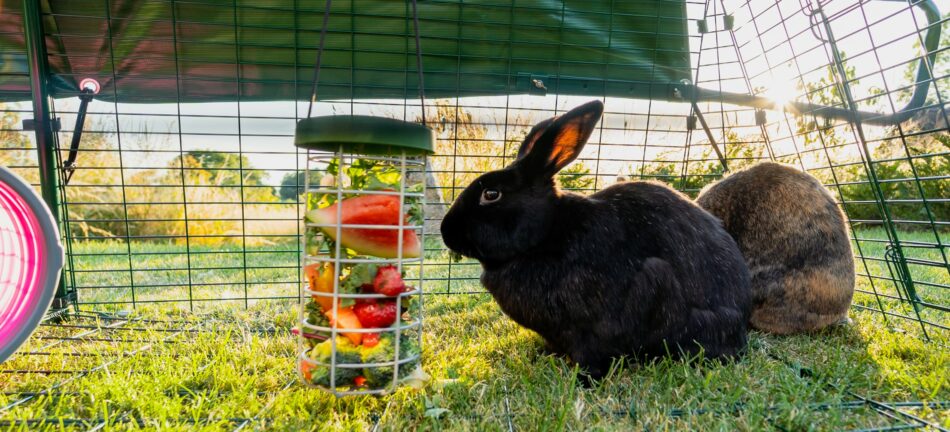
This entry was posted in Rabbits















 Thinking she would be a perfect match for Jensen, Wendy took Pixie home. She had divided the rabbit house so that she could slowly introduce them. After about a month, they were lying next to each other, separated only by the wire, so Wendy decided it was time. But Pixie was traumatised and her fear presented in aggressive behaviour. She couldn’t handle it and bit Jensen. She was agitated and frightened of everything. For a while, even putting food down for her was tricky. She would lunge at the hands that fed her. It was a terribly sad time for Wendy to see Pixie so distressed.
Thinking she would be a perfect match for Jensen, Wendy took Pixie home. She had divided the rabbit house so that she could slowly introduce them. After about a month, they were lying next to each other, separated only by the wire, so Wendy decided it was time. But Pixie was traumatised and her fear presented in aggressive behaviour. She couldn’t handle it and bit Jensen. She was agitated and frightened of everything. For a while, even putting food down for her was tricky. She would lunge at the hands that fed her. It was a terribly sad time for Wendy to see Pixie so distressed.


 If you were to meet a species of animal for the first time and had to make an accurate guess about its diet, you would get lots of clues by looking at its teeth. The teeth of a dog, like the teeth of a bear, proclaim loud and clear that this animal is an omnivore – that is, one that eats both meat and vegetables. If you think of your dog as a domesticated wolf, you get a good idea of its natural diet.
If you were to meet a species of animal for the first time and had to make an accurate guess about its diet, you would get lots of clues by looking at its teeth. The teeth of a dog, like the teeth of a bear, proclaim loud and clear that this animal is an omnivore – that is, one that eats both meat and vegetables. If you think of your dog as a domesticated wolf, you get a good idea of its natural diet.
 1. Rabbits
1. Rabbits


































